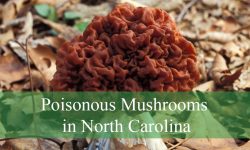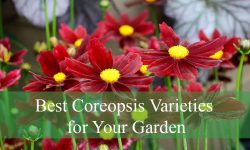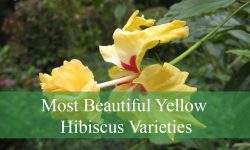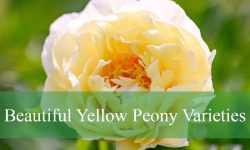Types of Sedum Plants offer one of the most diverse and resilient selections in the world of succulents. Known for their fleshy leaves, vibrant blooms, and exceptional drought tolerance, sedums—also called stonecrops—thrive in a wide range of garden settings. These adaptable plants can be used to cover ground, fill containers, or bring structure and color to vertical displays.
Gardeners love sedums not just for their low-maintenance nature, but also for their remarkable variety in color, texture, and growth habits. Creeping groundcovers, mounding forms, and upright flowering types all fall under the wide umbrella of types of Sedum plants. Many of them also display seasonal color changes, providing extra visual interest throughout the year.
This guide introduces 60 stunning types of Sedum plants, complete with detailed descriptions, identification tips, and growing advice. Ideal for both beginners and experienced gardeners alike, these selections will help you explore the full beauty and versatility that sedums bring to any outdoor space.
Different Types of Sedum Plants
Sedum spectabile (Hylotelephium spectabile) – Showy Stonecrop
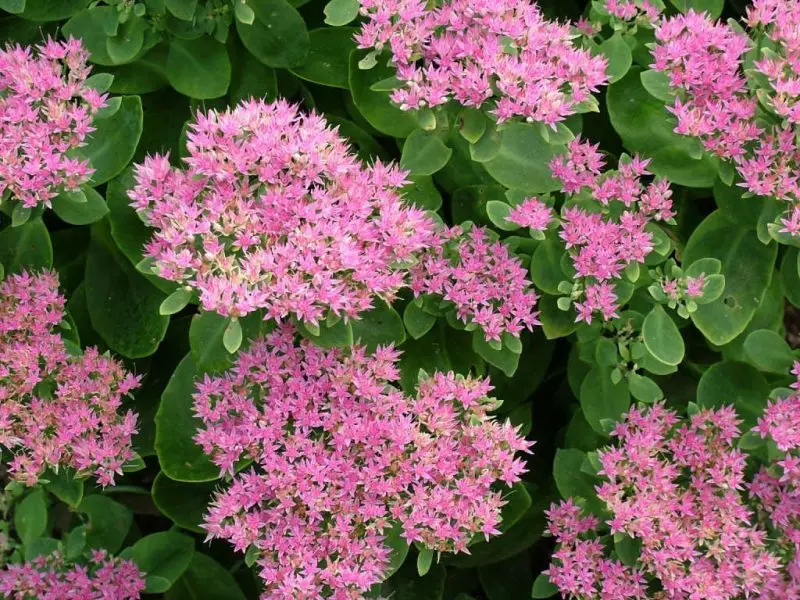
Sedum spectabile, also known as Showy Stonecrop, is a popular upright sedum variety known for its fleshy, gray-green leaves and clusters of pink, star-shaped flowers. Blooming in late summer to early fall, it adds color and texture to borders and rock gardens. Mature plants can reach about 18–24 inches tall and are excellent pollinator attractors.
It’s easy to identify this sedum by its thick stems, oval leaves arranged in whorls, and broad flower heads that resemble broccoli before blooming. The blossoms start pale pink and deepen to rosy red, creating a stunning display as the season progresses.
Grow Sedum spectabile in full sun with well-draining soil. It thrives in USDA zones 3–9 and tolerates drought once established. Minimal watering is required, and cutting back dead stems in late winter or early spring will promote healthy growth.
Sedum ‘Autumn Joy’ (Hylotelephium ‘Herbstfreude’)
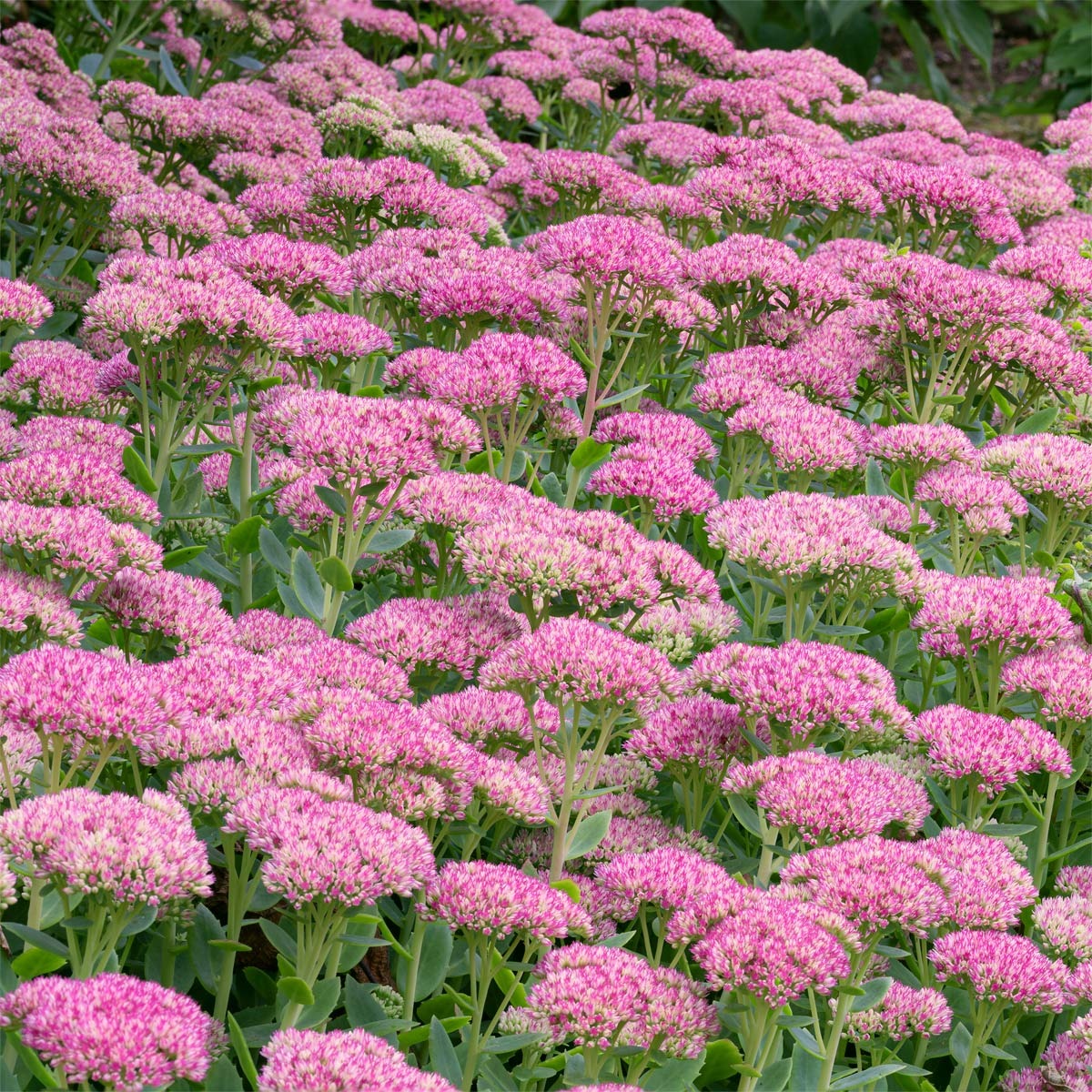
Sedum ‘Autumn Joy’ is one of the most beloved stonecrops for its striking seasonal interest. It forms upright, clump-forming mounds of fleshy green leaves topped with large, flat-topped flower heads. These buds open to light pink and mature to a rusty red, remaining attractive even into winter.
Its distinctive look includes thick succulent leaves and pink-bronze flower heads that resemble cauliflower clusters. The plant can grow up to 24 inches tall and attracts butterflies, bees, and other beneficial insects during its bloom period.
This sedum prefers full sun and dry, well-drained soil. It performs well in USDA zones 3–9 and is perfect for xeriscaping or low-maintenance perennial beds. Prune spent flower stalks in late winter or early spring to keep it tidy.
Sedum rupestre ‘Angelina’ – Angelina Stonecrop
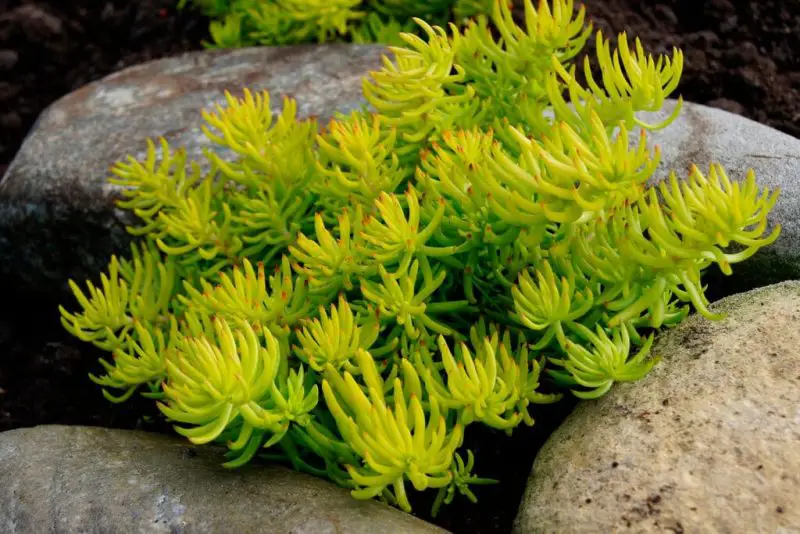
Sedum rupestre ‘Angelina’ is a mat-forming, evergreen groundcover with needle-like, golden-yellow foliage that turns orange or red in cold weather. Its fine texture and vibrant color make it a favorite in rock gardens, containers, and borders.
The plant typically grows 4–6 inches tall and spreads quickly. Small, star-shaped yellow flowers appear in mid to late summer but are not the main attraction. Its trailing stems and bright foliage offer year-round ornamental appeal.
‘Angelina’ thrives in full sun and poor, sandy soils with excellent drainage. It’s hardy in USDA zones 5–9 and is drought-tolerant once established. Water sparingly, especially in winter, and trim back to maintain shape if needed.
Sedum spurium ‘Dragon’s Blood’
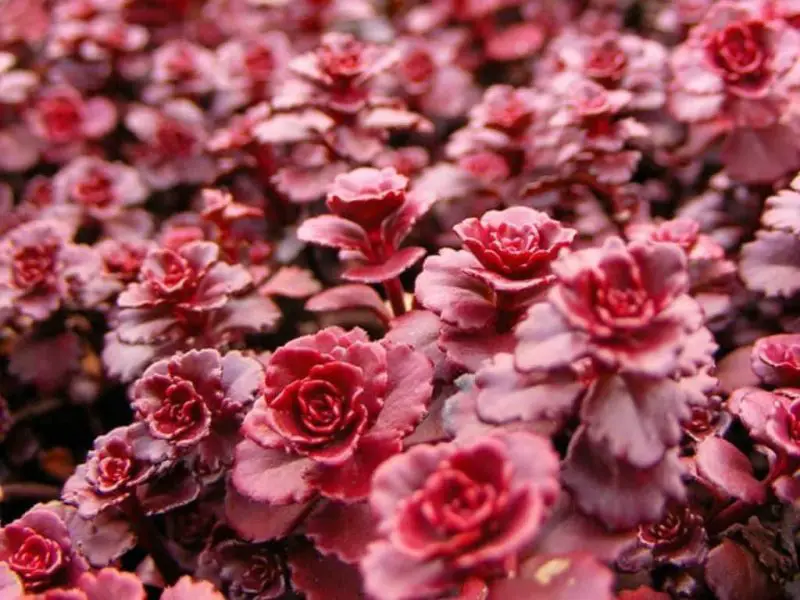
Sedum spurium ‘Dragon’s Blood’ is a vibrant groundcover known for its deep burgundy-red foliage and pink-red blooms. The foliage darkens in cooler weather, making it a standout plant through multiple seasons. It’s excellent for edging, slopes, or rock gardens.
You can identify ‘Dragon’s Blood’ by its low, spreading growth habit and scalloped leaves that range from green to dark red. Clusters of small, starry flowers bloom in summer, enhancing the visual appeal of the already dramatic foliage.
It grows best in full sun and well-drained soil, thriving in USDA zones 3–9. It tolerates heat, drought, and poor soil, making it very low-maintenance. Trim after flowering to keep a compact form and encourage denser growth.
Sedum acre – Goldmoss Stonecrop
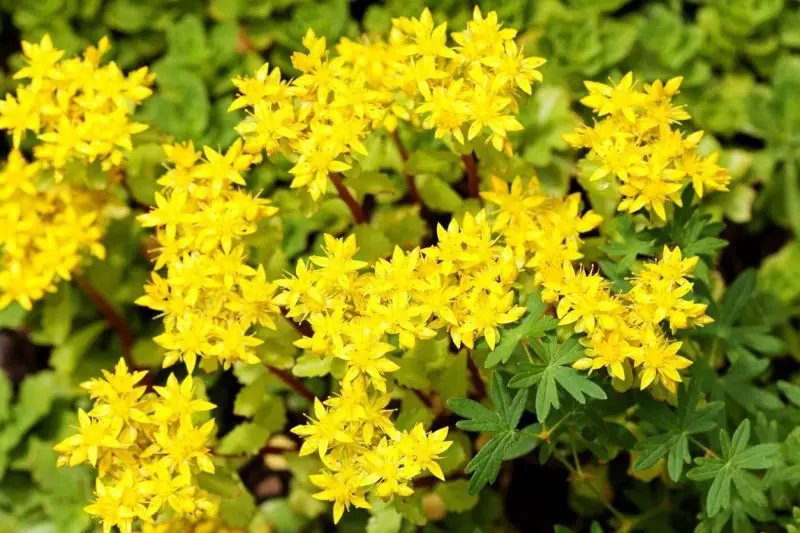
Sedum acre, or Goldmoss Stonecrop, is a fast-spreading groundcover with tiny, needle-like green leaves and brilliant yellow star-shaped flowers in late spring to early summer. It forms a dense carpet that’s perfect for rockeries or between stepping stones.
Its miniature, succulent foliage gives it a mossy appearance, which inspired its common name. The leaves often turn reddish during cold or dry conditions, adding seasonal interest beyond its blooming period.
Goldmoss Stonecrop thrives in full sun and gritty, well-drained soils. It’s hardy in USDA zones 4–9 and requires minimal care. Water infrequently, avoid heavy soil, and divide or trim it if it spreads too aggressively.
Sedum album – White Stonecrop
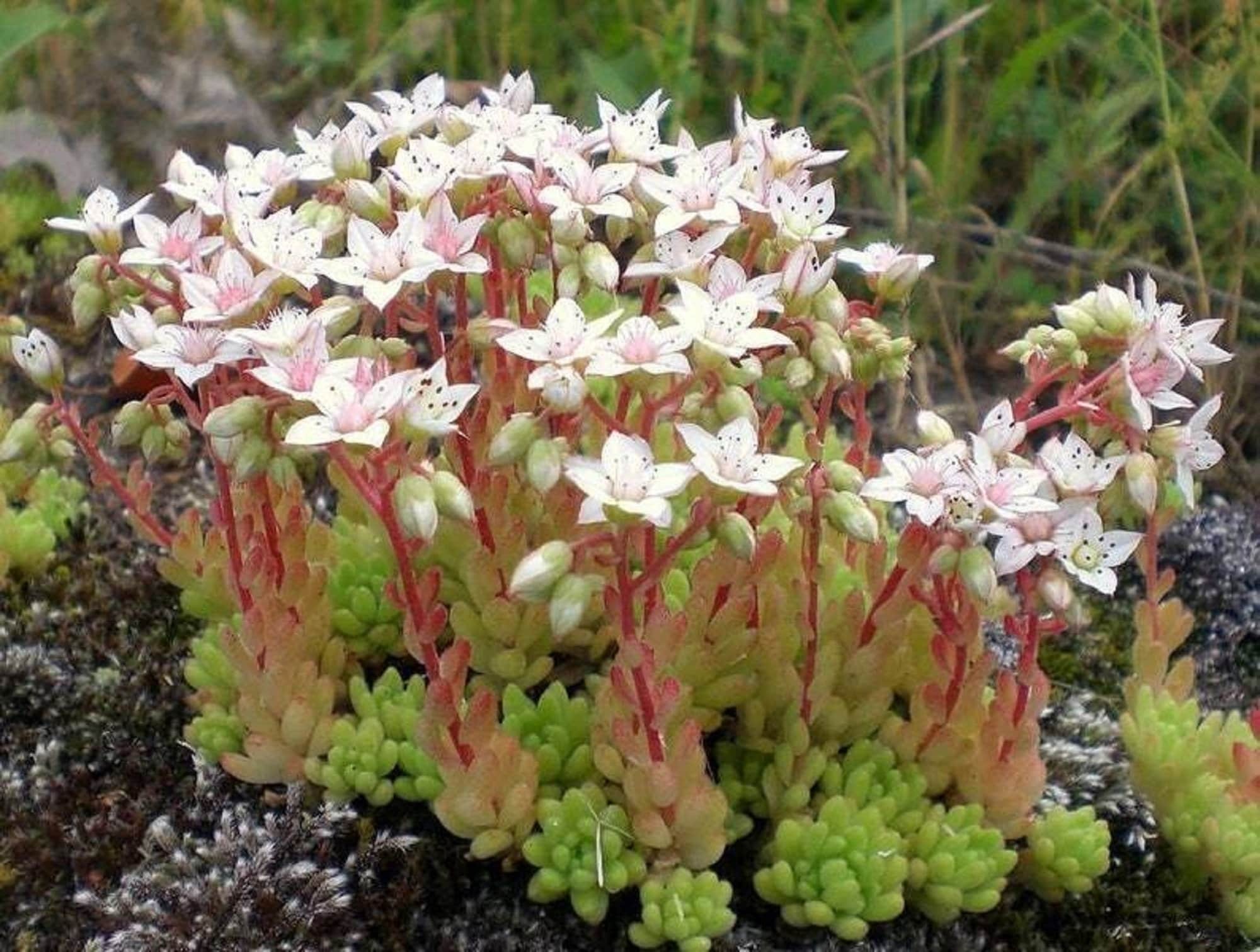
Sedum album, known as White Stonecrop, is a mat-forming perennial with small, rounded succulent leaves that range from green to reddish bronze. It blooms in summer with clusters of tiny white flowers that rise above the foliage.
This low-growing sedum typically reaches just a few inches tall, making it ideal for groundcovers, green roofs, or container arrangements. The foliage often changes color with the seasons, giving it a dynamic look year-round.
White Stonecrop thrives in full sun and gritty, dry soil. It’s hardy in USDA zones 3–9 and needs very little water or maintenance. It spreads easily but is not overly aggressive, and trimming after flowering can refresh its appearance.
Sedum reflexum – Jenny’s Stonecrop
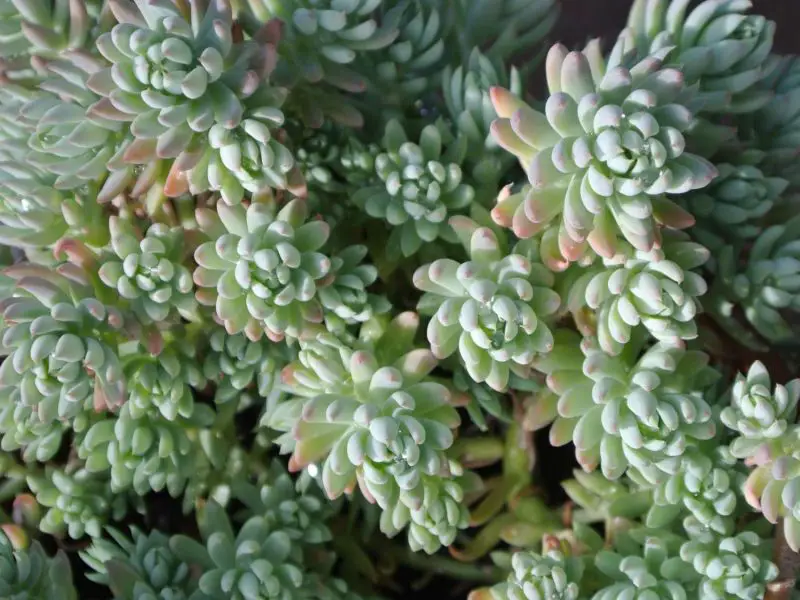
Sedum reflexum, commonly known as Jenny’s Stonecrop or Blue Spruce Stonecrop, is a low-growing evergreen with spiky, blue-green foliage that resembles the needles of a spruce tree. It spreads quickly, forming a dense mat perfect for rock gardens, ground covers, and container edges. In summer, it produces clusters of bright yellow star-shaped flowers.
This sedum is easily recognized by its unique needle-like leaves, which grow in whorls along upright stems. The foliage often turns reddish at the tips in cooler months, adding a pop of seasonal color. It typically grows about 4–6 inches tall but spreads widely.
It thrives in full sun and dry, well-drained soils, performing well in USDA zones 5–9. Very drought-tolerant, it requires minimal watering once established. Prune back after flowering to maintain a tidy appearance and prevent legginess.
Sedum sieboldii – October Daphne
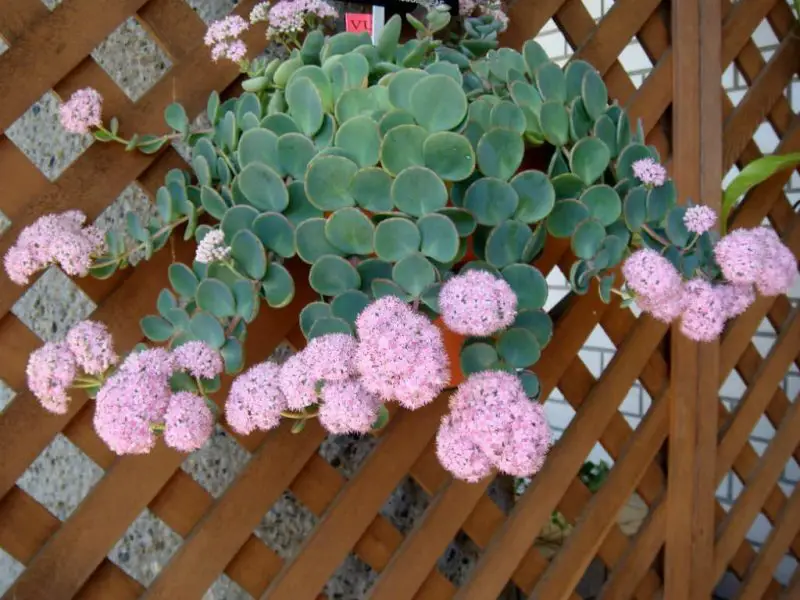
Sedum sieboldii, also known as October Daphne, is a charming trailing sedum with round, blue-green leaves edged in pink. This variety produces clusters of bright pink flowers in the fall, providing a burst of color when many other plants are fading. It is especially well-suited for containers, rock walls, and hanging baskets.
Its foliage grows in whorls along arching stems, often developing rosy hues in cooler weather. The pink-edged leaves and autumn blooms make it a favorite among gardeners looking for late-season interest.
This sedum prefers full sun to partial shade and well-drained soil. It is hardy in USDA zones 6–9 and does best in moderately dry conditions. Water sparingly, and protect from excessive winter moisture, especially in poorly drained soils.
Sedum morganianum – Burro’s Tail
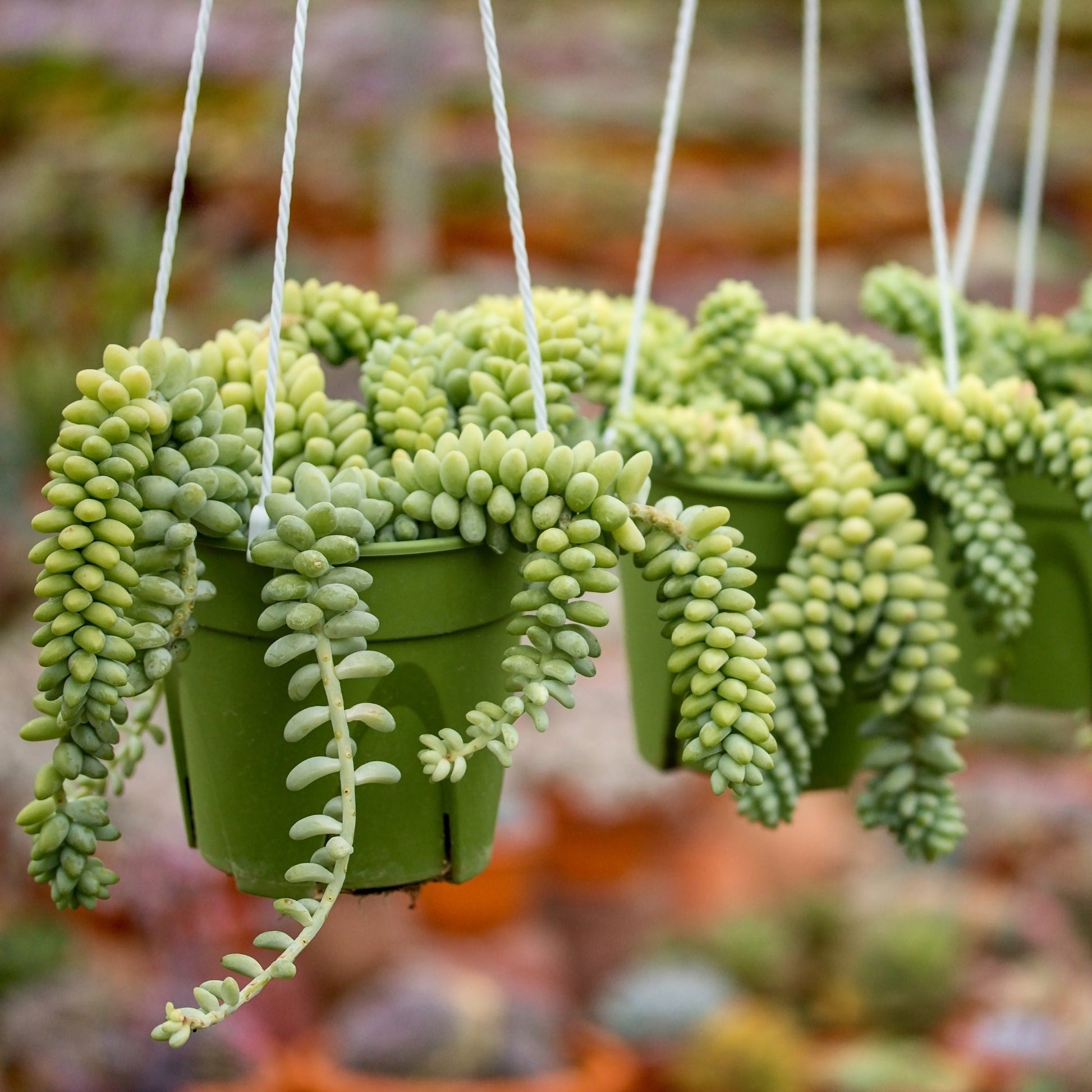
Sedum morganianum, commonly called Burro’s Tail or Donkey Tail, is a trailing succulent prized for its long, hanging stems covered in plump, teardrop-shaped leaves. Its cascading habit makes it a stunning choice for hanging baskets or high ledges. The plant can produce small, pink to red flowers in summer, although blooms are rare indoors.
The thick, blue-green leaves are densely packed along fragile stems, giving the appearance of braided tails. The stems can reach lengths of over 24 inches, but they are delicate and can easily drop leaves when handled.
Burro’s Tail thrives in bright, indirect light and well-drained, sandy soil. It is best grown indoors in USDA zones 9–11, as it is sensitive to frost. Allow the soil to dry out completely between waterings, and avoid touching the stems too often to prevent damage.
Sedum pachyphyllum – Jelly Bean Plant

Sedum pachyphyllum, known as the Jelly Bean Plant, is a compact, whimsical succulent with chubby, cylindrical leaves that resemble jelly beans. These green leaves often blush red at the tips when exposed to bright light or cooler temperatures, giving the plant a colorful and playful appearance.
It grows in small mounding clumps and may produce yellow, star-shaped flowers in the summer. Its low height and charming form make it ideal for containers, succulent arrangements, and rock gardens.
This sedum requires full sun to light shade and well-draining soil. It performs best in USDA zones 9–11 and should be protected from frost. Water sparingly, letting the soil dry out between waterings, and provide extra sunlight to maintain its red-tipped leaf coloration.
Sedum rubrotinctum – Pork and Beans
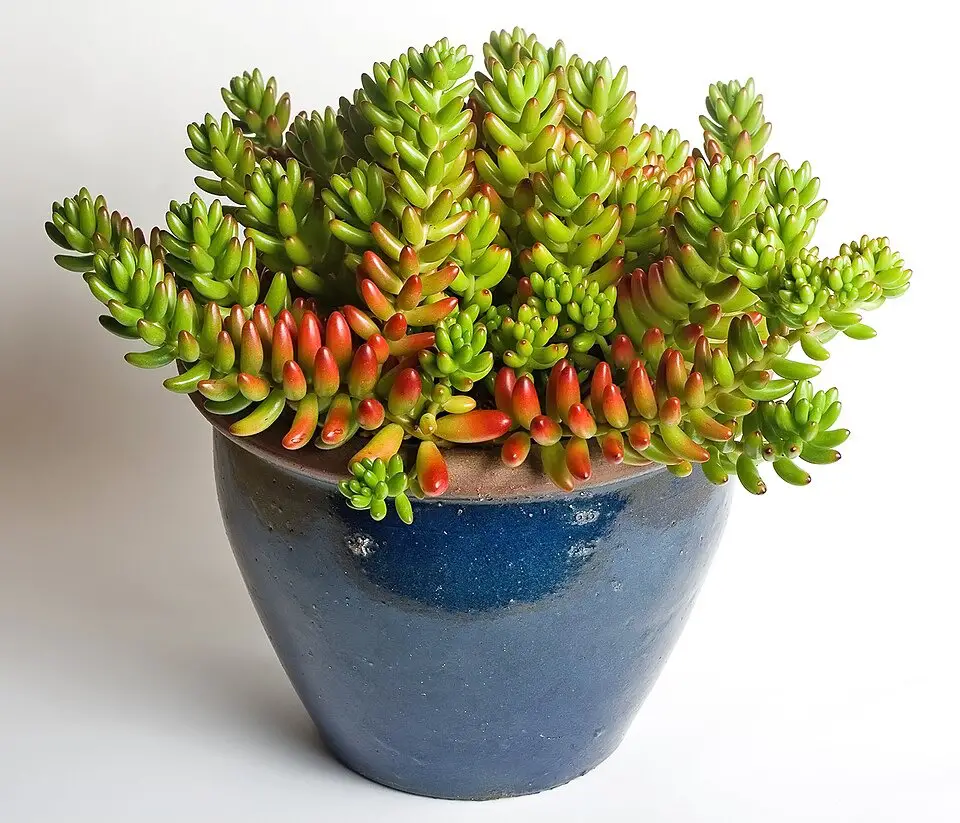
Sedum rubrotinctum, also called Pork and Beans or Jelly Bean Plant, features small, plump leaves that shift from green to reddish-bronze in full sun. Its whimsical appearance and tolerance to drought make it a popular choice for indoor succulent gardens and patio containers.
The leaves resemble tiny beans and grow densely along trailing stems. Yellow star-shaped flowers may appear in spring or early summer. Its playful look and low-maintenance needs have made it a favorite among succulent collectors.
It grows best in full sun to partial shade with well-drained soil and thrives in USDA zones 9–11. Be careful with overwatering, especially in containers. Let soil dry out completely before rewatering, and protect the plant from frost or freezing temperatures.
Sedum kamtschaticum – Orange Stonecrop
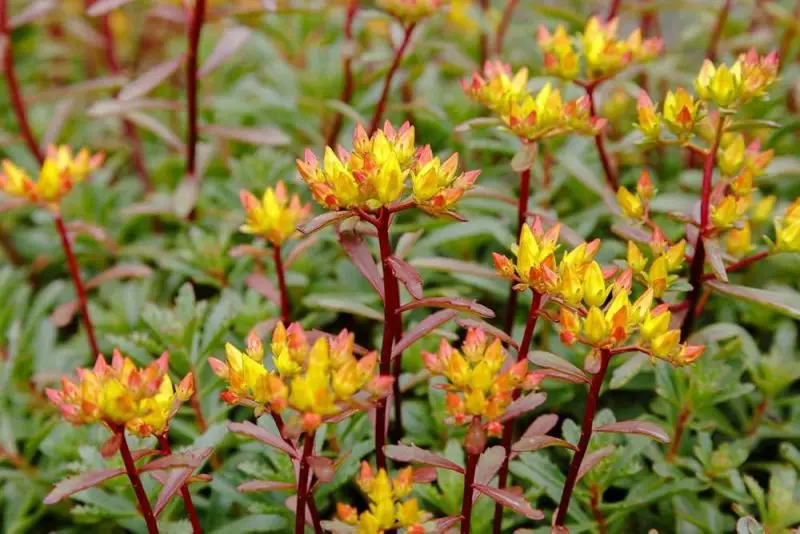
Sedum kamtschaticum, commonly known as Orange Stonecrop, is a mat-forming perennial with glossy green, toothed leaves and bright yellow-orange star-shaped flowers that bloom in late spring to early summer. It forms a dense carpet and is ideal for covering slopes or filling gaps in rock gardens.
This sedum has a spreading habit and grows up to 6 inches tall, with foliage that may develop red tints in the fall. The golden blooms attract pollinators, and the plant’s ability to withstand poor soil makes it a tough, reliable choice.
It thrives in full sun and well-drained soil, adapting well to drought conditions. Hardy in USDA zones 3–8, it requires little maintenance once established. Trim back dead stems in early spring and divide the clumps every few years to refresh growth.
Sedum tetractinum – Chinese Sedum
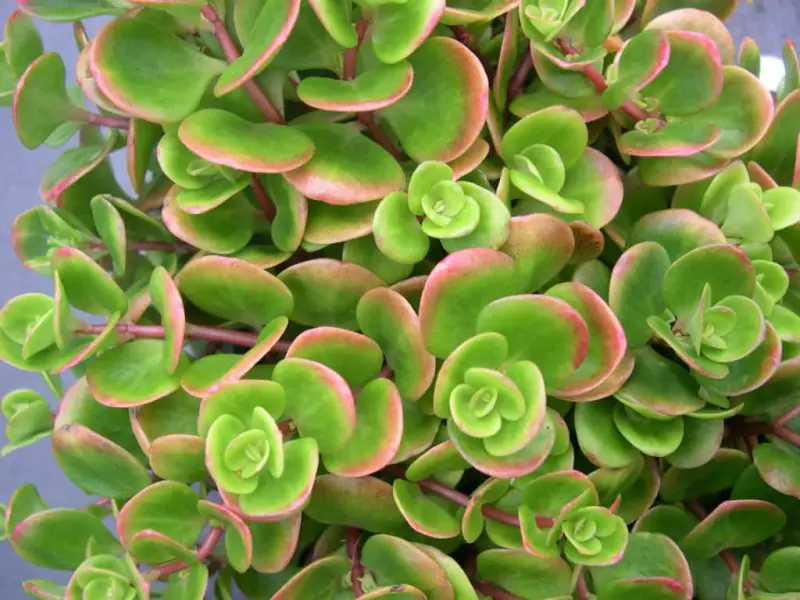
Sedum tetractinum, commonly known as Chinese Sedum, is a low-growing, mat-forming species with rounded, scalloped green leaves that often turn bronze or red in the fall. This sedum spreads well across soil and stone surfaces, making it ideal for ground cover, especially in rock gardens and borders.
Its small, star-shaped yellow flowers bloom in midsummer and provide a soft contrast to the deepening leaf colors. The plant grows about 2 to 4 inches tall and spreads rapidly, rooting at the nodes as it creeps along the ground.
Chinese Sedum thrives in full sun to partial shade and prefers well-drained soil. It performs best in USDA zones 4–9 and is both drought-tolerant and deer-resistant. Water moderately and trim back as needed to control spread and encourage dense growth.
Sedum makinoi ‘Ogon’
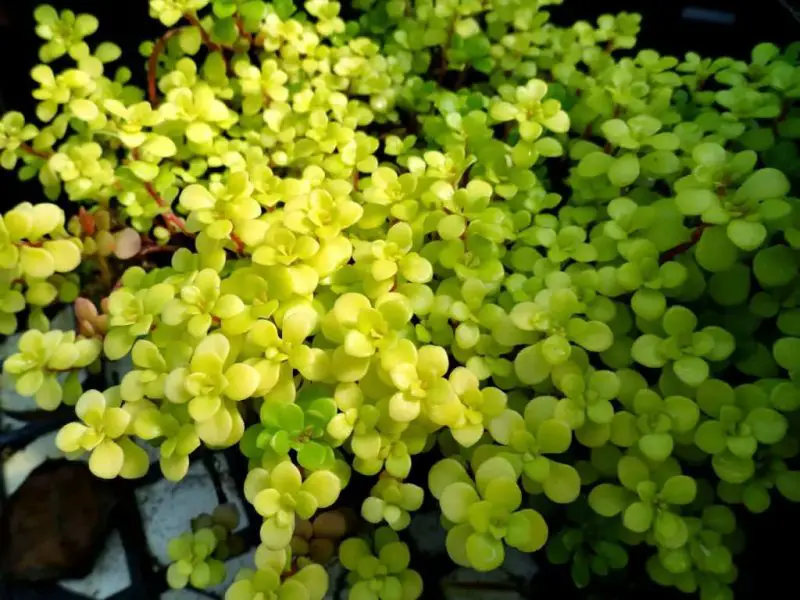
Sedum makinoi ‘Ogon’ is a striking, low-growing cultivar with bright, golden-yellow, round leaves that form dense mats of color. Its vivid foliage provides a year-round splash of brightness in containers, rock gardens, or as edging in garden beds.
This variety features tiny, yellow star-shaped flowers in summer, though the foliage is the main ornamental attraction. Its compact growth habit and spreading nature make it a popular choice for small spaces and mixed succulent displays.
‘Ogon’ grows well in partial shade to full sun and prefers moist, well-drained soil. It’s hardy in USDA zones 6–9 and appreciates some protection from intense midday sun, which can scorch the delicate leaves. Regular watering is helpful, especially in hot, dry weather.
Sedum sarmentosum – Stringy Stonecrop
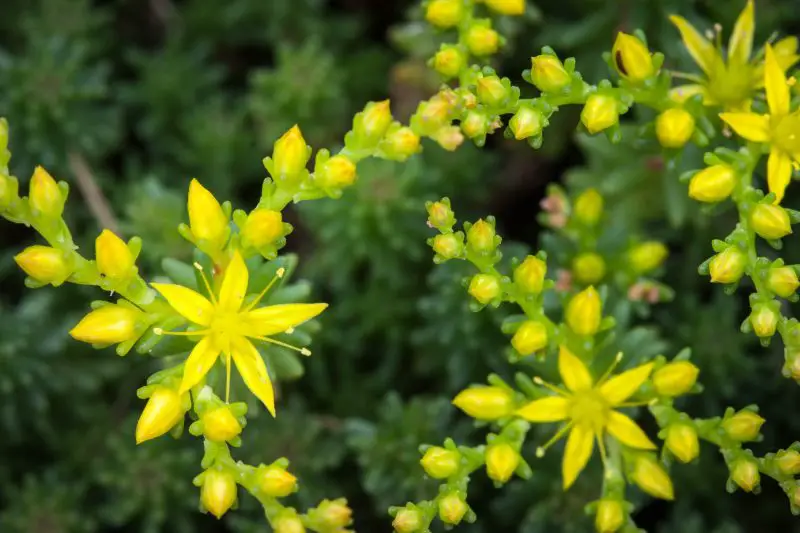
Sedum sarmentosum, or Stringy Stonecrop, is a vigorous, fast-spreading sedum with narrow, lance-shaped green leaves and bright yellow star-shaped flowers in summer. It is one of the most aggressive groundcovers among sedums, capable of quickly colonizing garden areas.
Its wiry, trailing stems root easily where they touch the soil, allowing it to form dense mats over large areas. The foliage may take on reddish hues in cooler temperatures, adding seasonal interest.
This sedum thrives in full sun to partial shade and is tolerant of various soil types, provided drainage is good. It’s hardy in USDA zones 4–9 and is a good choice for erosion control, though it may require regular trimming to prevent overgrowth.
Sedum dasyphyllum – Corsican Stonecrop

Sedum dasyphyllum, known as Corsican Stonecrop, is a tiny, trailing succulent with blue-gray to purplish rounded leaves that form tight rosettes. Its delicate appearance makes it ideal for fairy gardens, container arrangements, and cracks in stone pathways.
The plant blooms in late spring to early summer with tiny white to pale pink flowers, adding charm to its already dainty foliage. It only reaches 1 to 3 inches in height but spreads well along soil and rock surfaces.
Corsican Stonecrop does best in full sun and gritty, well-drained soils. It is hardy in USDA zones 5–9 and requires little watering once established. Avoid overwatering, especially in humid conditions, to prevent rot in the compact rosettes.
Sedum hispanicum – Spanish Stonecrop
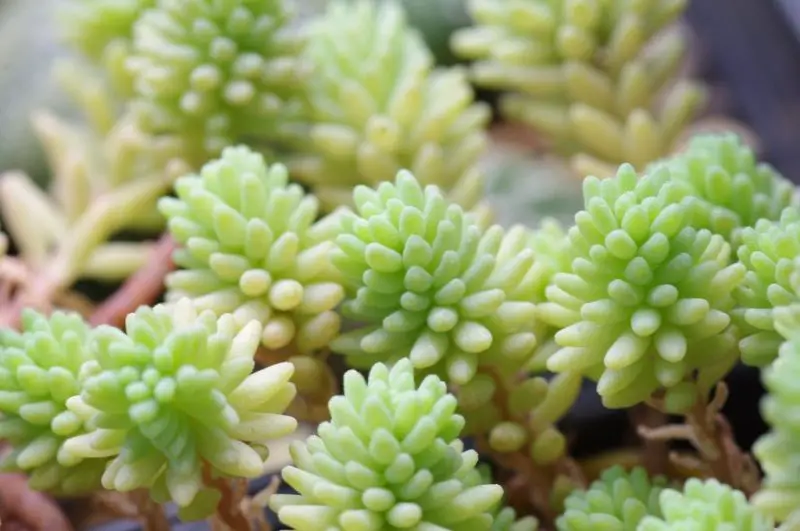
Sedum hispanicum, or Spanish Stonecrop, is a low-growing, carpeting sedum with tiny, needle-like leaves that shift from green to shades of purple, blue, or pink depending on the season. This variety is especially valued for its colorful foliage and fine texture.
It produces small, star-shaped white or pale pink flowers in early summer. The plant stays under 3 inches tall and spreads gradually, making it perfect for alpine gardens, rockeries, or in between stepping stones.
This sedum thrives in full sun and sandy, well-drained soil. Hardy in USDA zones 4–9, it is drought-tolerant and well-suited for hot, dry areas. Minimal care is needed beyond occasional watering during extended dry periods.
Sedum oreganum – Oregon Stonecrop
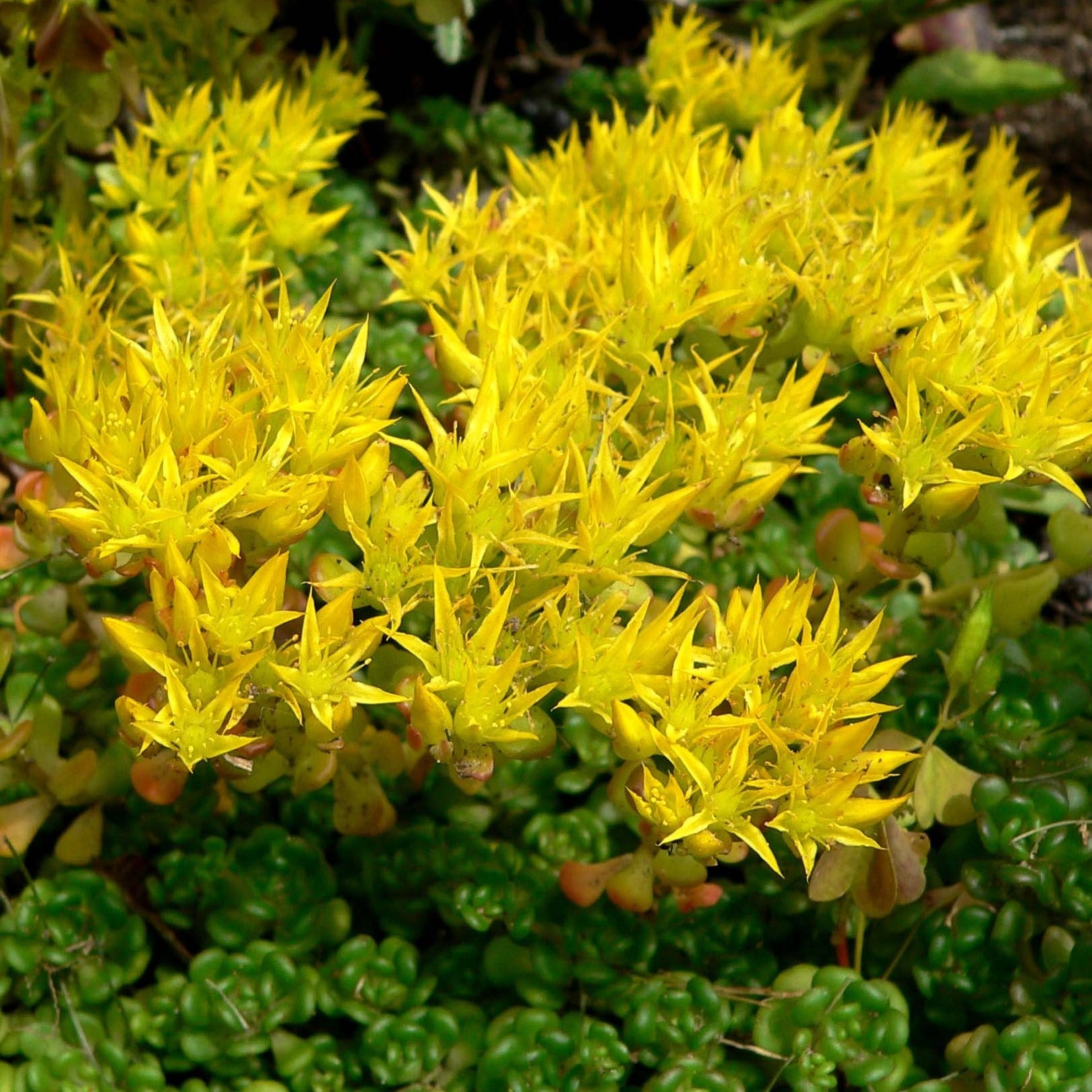
Sedum oreganum, known as Oregon Stonecrop, is a native North American sedum with fleshy, rounded green leaves that sometimes take on a reddish hue in cool weather. It forms a low mat that thrives in coastal and mountainous environments.
This variety produces cheerful yellow flowers in summer, rising slightly above the foliage on short stems. Its spreading habit and tolerance for poor soils make it ideal for naturalistic plantings, green roofs, and rock walls.
Oregon Stonecrop is hardy in USDA zones 5–9 and prefers full sun to partial shade. It tolerates drought, rocky soils, and salt spray, making it an excellent choice for tough growing conditions. Water sparingly and allow the soil to dry between waterings.
Sedum ternatum – Woodland Stonecrop
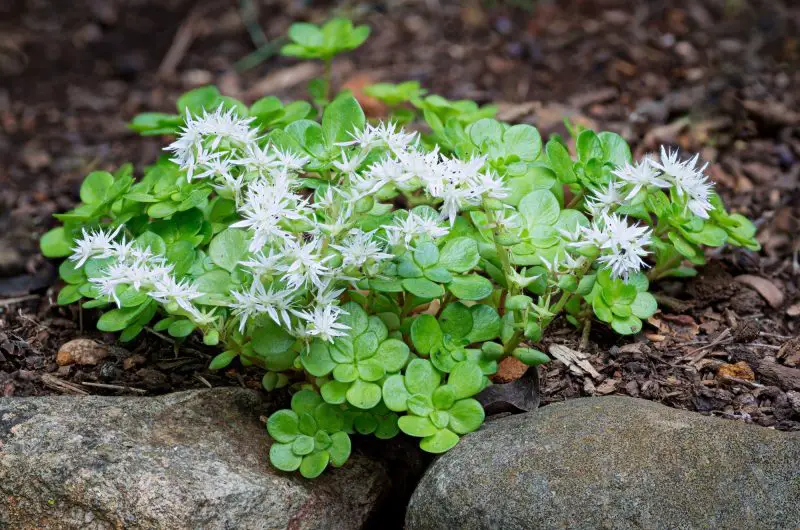
Sedum ternatum, commonly called Woodland Stonecrop, is one of the few sedums that naturally grows in shady environments. It features small, bright green leaves arranged in whorls of three, forming a lush carpet across forest floors or shaded garden beds.
In late spring to early summer, it produces delicate, starry white flowers that rise above the foliage, adding a subtle brightness to darker garden areas. It typically grows 3 to 6 inches tall and spreads moderately by creeping stems.
This sedum prefers partial to full shade and moist, well-drained soil, making it an excellent ground cover for shaded borders and woodland gardens. Hardy in USDA zones 4–8, it requires little maintenance once established and is tolerant of light foot traffic.
Sedum sexangulare – Tasteless Stonecrop
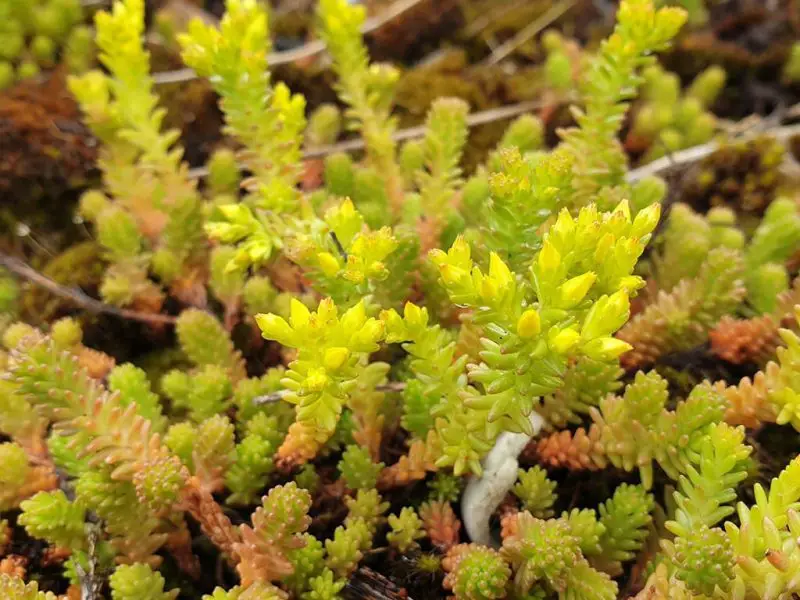
Sedum sexangulare, or Tasteless Stonecrop, is a fast-spreading, moss-like sedum with fine, needle-shaped green leaves arranged in six spirals around the stem—hence the name “sexangulare.” Its dense texture makes it a lovely ground cover or filler between pavers.
It blooms in summer with clusters of small, bright yellow star-shaped flowers that attract pollinators and contrast nicely with the vibrant foliage. The plant grows 2 to 4 inches tall and spreads readily by creeping stems.
This hardy sedum thrives in full sun and well-drained soil and is tolerant of drought and poor soils. It performs best in USDA zones 3–9 and can be used in rock gardens, walls, and containers with minimal care and occasional watering.
Sedum lineare – Carpet Sedum

Sedum lineare, often referred to as Carpet Sedum or Needle Stonecrop, is a low-growing, mat-forming species with linear, lime-green leaves arranged in dense whorls along creeping stems. It quickly covers soil, stone, or container surfaces with a soft, grassy texture.
Small yellow flowers appear in late spring to early summer, rising just above the foliage and adding seasonal interest. This sedum is often used as a living mulch or to fill in gaps in succulent arrangements and rock gardens.
Best grown in full sun to light shade, Sedum lineare prefers well-drained soil and is hardy in USDA zones 6–9. It tolerates heat, drought, and moderate foot traffic, making it a practical and attractive ground cover in warm climates.
Sedum spurium ‘Tricolor’
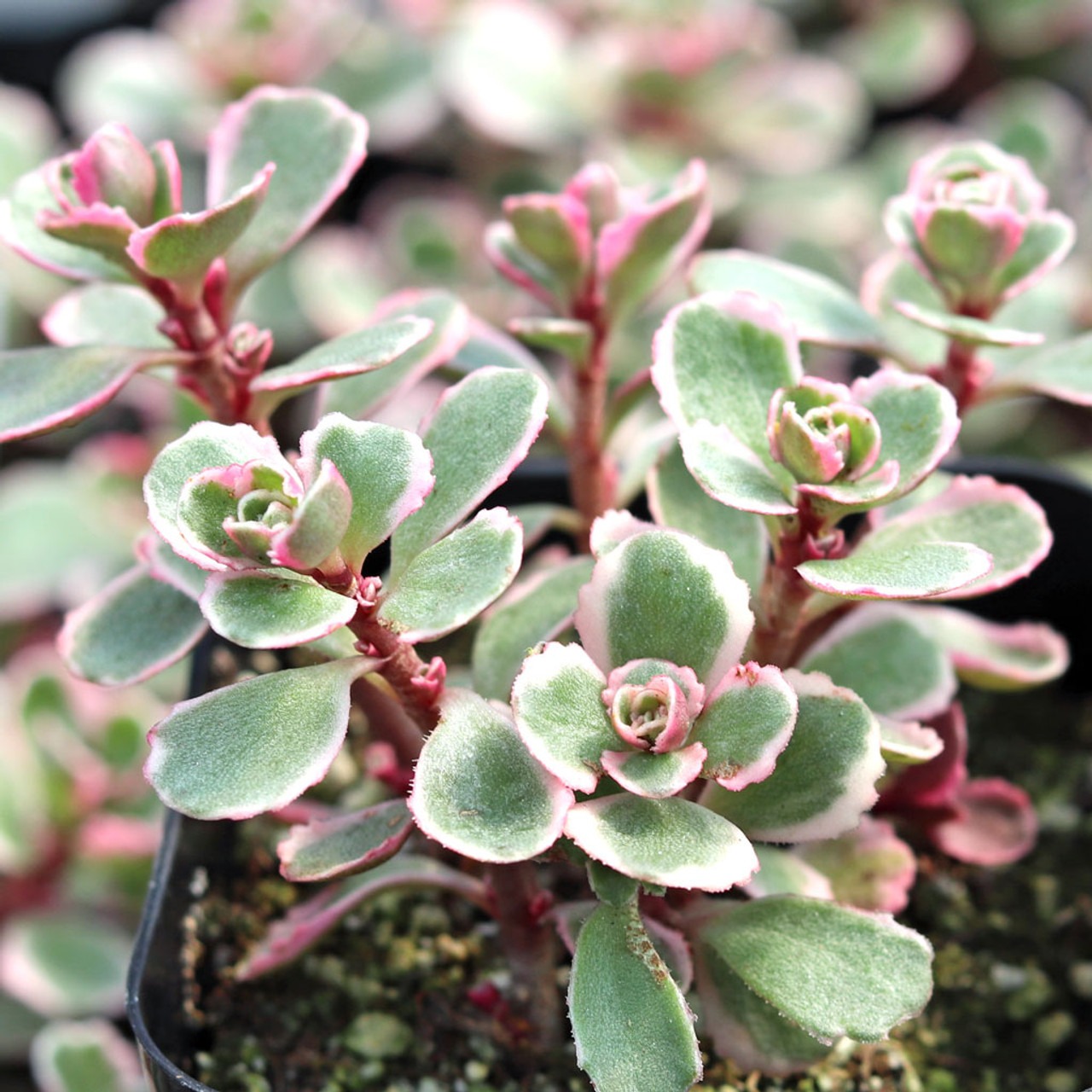
Sedum spurium ‘Tricolor’ is a colorful, eye-catching variety with small, rounded leaves variegated in green, white, and pink. The pink tones become more vivid in cooler temperatures, providing year-round color in borders and containers.
Clusters of tiny, rosy-pink flowers bloom in midsummer, adding a lovely contrast to the pastel foliage. Its low, trailing habit (4 to 6 inches tall) and spreading form make it ideal for ground cover, edging, or hanging baskets.
‘Tricolor’ thrives in full sun and well-drained soil. Hardy in USDA zones 3–9, it is drought-tolerant and deer-resistant. Occasional pruning helps maintain a tidy shape and encourages fresh, colorful growth.
Sedum spurium ‘Voodoo’
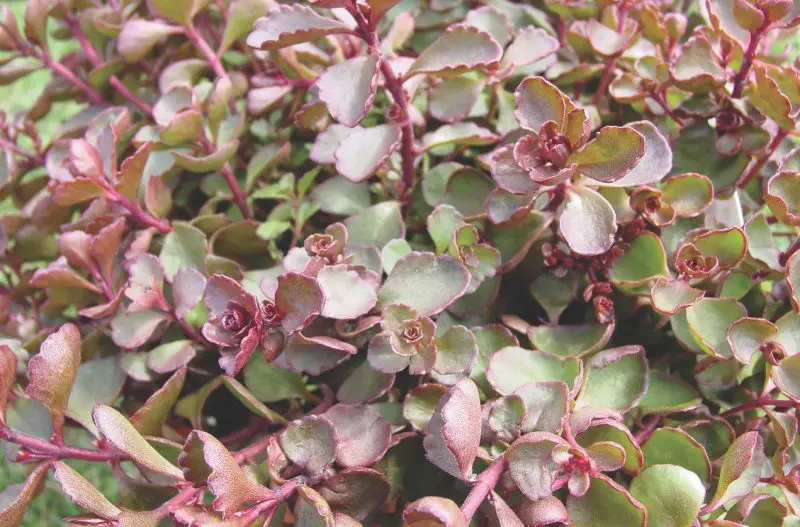
Sedum spurium ‘Voodoo’ is known for its striking burgundy-red foliage that deepens in color with sun exposure. The thick, succulent leaves form a dense carpet, offering dramatic contrast in succulent gardens and mixed plantings.
Bright pink-red star-shaped flowers bloom in summer, attracting pollinators and adding even more vibrant color. It stays compact, growing about 4 inches tall while spreading steadily through creeping stems.
This cultivar prefers full sun and gritty, well-drained soil. It performs well in USDA zones 3–9 and is especially heat- and drought-tolerant. Minimal watering and occasional trimming will keep ‘Voodoo’ looking bold and tidy.
Sedum spurium ‘John Creech’

Sedum spurium ‘John Creech’ is a dense, mat-forming ground cover named after a former U.S. National Arboretum Director. It features rounded, scalloped green leaves that hug the ground and form thick mats perfect for erosion control or filler between stones.
In summer, clusters of pink flowers rise slightly above the foliage, attracting bees and butterflies. This sedum is known for its vigorous growth and resistance to weeds, making it a favorite in tough landscaping spots.
It grows well in full sun and tolerates poor, dry soil with ease. Hardy in USDA zones 3–9, ‘John Creech’ is a dependable, low-maintenance variety that requires little more than occasional watering and division to thrive.
Sedum reflexum ‘Blue Spruce’
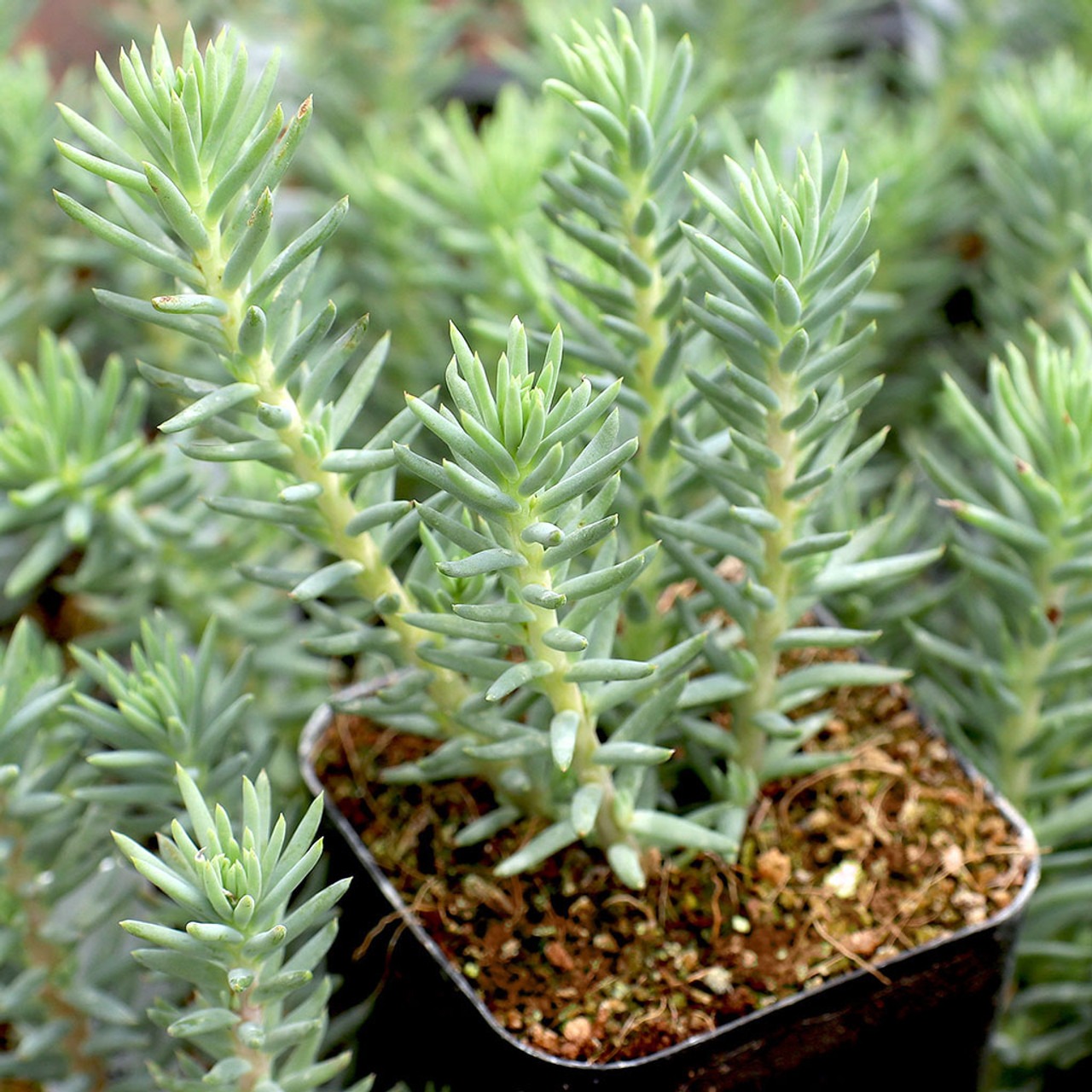
Sedum reflexum ‘Blue Spruce’ is named for its bluish-gray needle-like foliage that closely resembles the needles of a spruce tree. This unique leaf shape gives the plant a textured, evergreen appearance even in winter, making it a standout in succulent and rock gardens.
Bright yellow star-shaped flowers appear in early to mid-summer, providing a vibrant contrast against the cool-toned foliage. The plant grows 4 to 6 inches tall and spreads steadily, forming dense mats suitable for ground covers or borders.
‘Blue Spruce’ thrives in full sun and well-drained soil. Hardy in USDA zones 4–9, it is drought-tolerant, deer-resistant, and low-maintenance. Occasional trimming keeps it neat and encourages new growth.
Sedum telephium – Orpine
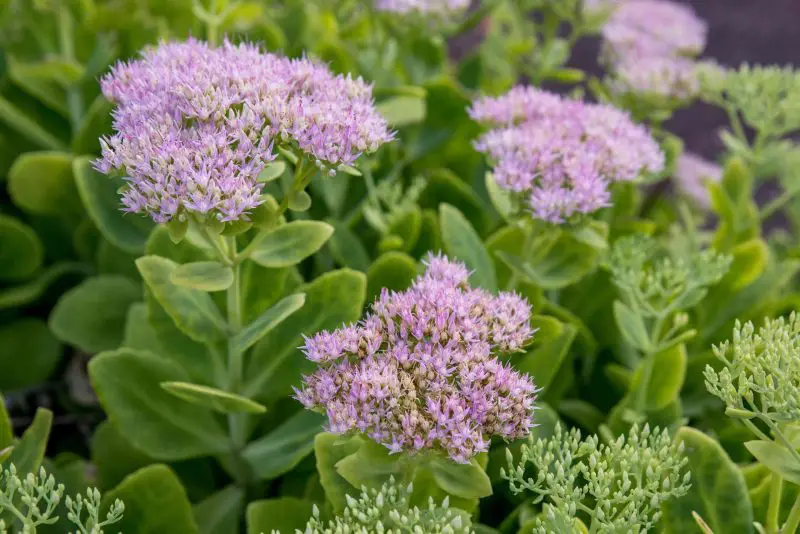
Sedum telephium, also known as Orpine or Live-forever, is a tall-growing species with upright stems and fleshy, ovate green to purplish leaves. It forms bushy clumps that bring a bold structure to perennial borders and pollinator gardens.
From late summer into fall, it blooms with large, flat-topped clusters of pink to reddish-purple flowers that attract butterflies and bees. The blooms often dry beautifully and persist into winter, adding seasonal interest.
This sedum prefers full sun to light shade and well-drained soil. Hardy in USDA zones 3–9, it is very adaptable and tolerant of drought once established. Cutting it back in early spring helps rejuvenate its upright form.
Sedum ‘Matrona’
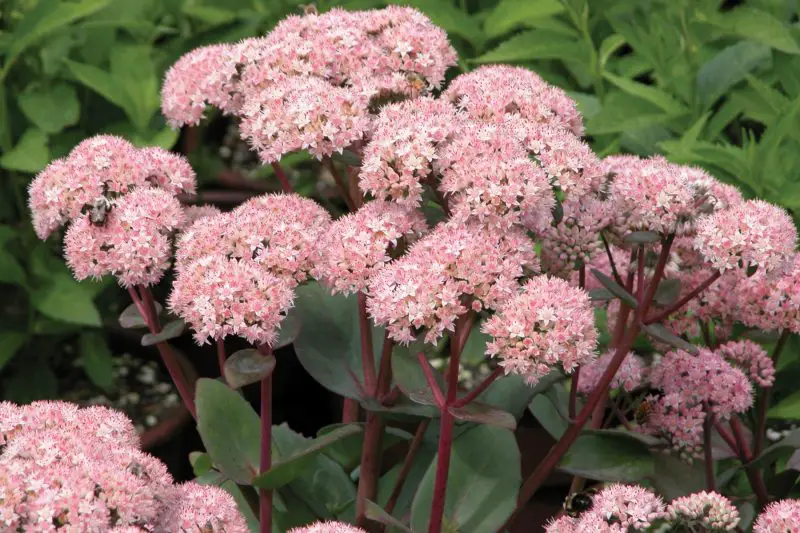
Sedum ‘Matrona’ is a statuesque cultivar featuring striking purplish stems, large grey-green leaves with rose-pink edges, and clusters of soft pink flowers. Its elegant form makes it a strong focal point in both modern and cottage-style gardens.
Flowering begins in late summer and continues into fall, with domed clusters of blossoms that draw in butterflies. The plant reaches about 18 to 24 inches tall and has a clump-forming habit that pairs well with ornamental grasses or echinacea.
‘Matrona’ grows best in full sun and well-drained soil. Hardy in USDA zones 3–9, it is drought-tolerant and thrives with minimal care. Leaving the seed heads over winter adds ornamental value and food for wildlife.
Sedum ‘Purple Emperor’
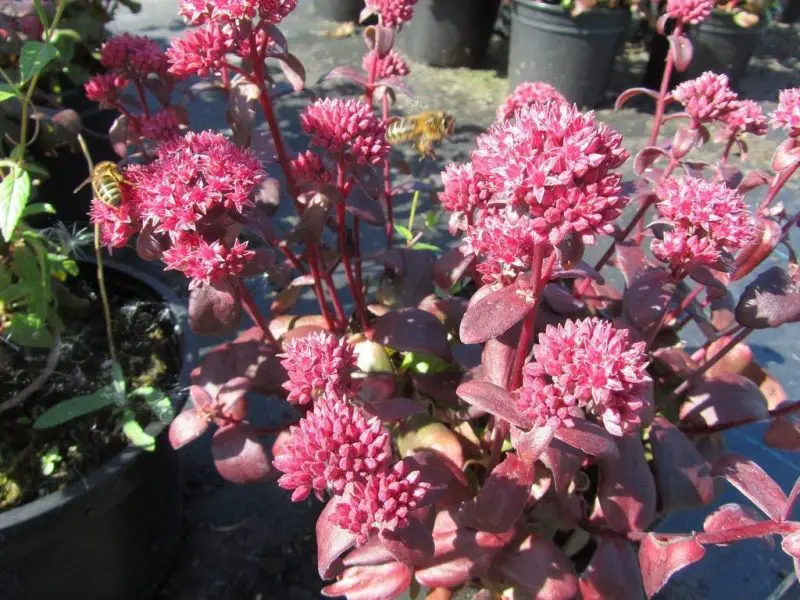
Sedum ‘Purple Emperor’ stands out with its rich, dark purple foliage and stems that maintain their dramatic color throughout the growing season. The plant has a compact, upright growth habit and adds strong contrast in mixed perennial beds.
Clusters of pink flowers bloom in late summer and attract bees and butterflies. The combination of dark leaves and light flowers creates a striking visual appeal that lasts through fall.
This variety prefers full sun and well-drained soil. Hardy in USDA zones 3–9, it’s a great low-maintenance choice for containers or borders, thriving with little more than seasonal pruning and occasional watering.
Sedum ‘Brilliant’
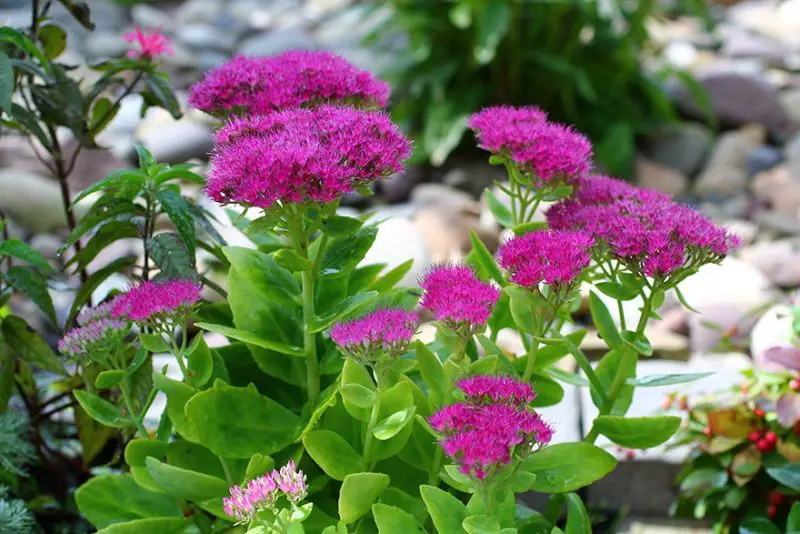
Sedum ‘Brilliant’ is a classic and popular tall sedum known for its neat mounding shape and bright green leaves. Its flower heads are large and dome-shaped, opening in late summer with clear, vibrant pink blooms that age to a soft rose color.
Reaching 18 to 24 inches tall, ‘Brilliant’ adds structure to flower beds and is highly attractive to pollinators. The blooms persist well into fall, and the dried seed heads can remain ornamental into winter.
This sedum grows best in full sun with well-drained soil. Hardy in USDA zones 3–9, it’s an excellent drought-tolerant plant that benefits from occasional division and cutting back in early spring to refresh its growth.
Sedum ‘Carl’
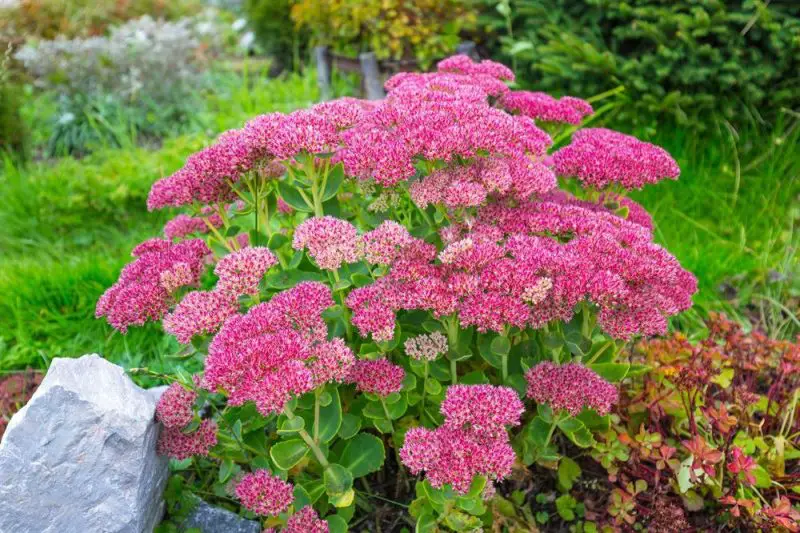
Sedum ‘Carl’ is a compact, upright sedum with fleshy blue-green leaves and bright pink flowers that appear in late summer. The blooms are dense, flat-topped, and loved by bees and butterflies, making it a lively addition to any pollinator garden.
It forms tidy clumps about 15 to 18 inches tall, with good resistance to flopping and a vibrant display that lasts into fall. The plant’s uniform habit and clean foliage make it a great choice for borders or containers.
‘Carl’ performs best in full sun and well-drained soil. Hardy in USDA zones 3–9, it thrives in heat and drought and needs little maintenance aside from spring trimming to promote fuller growth.
Sedum ‘Thundercloud’
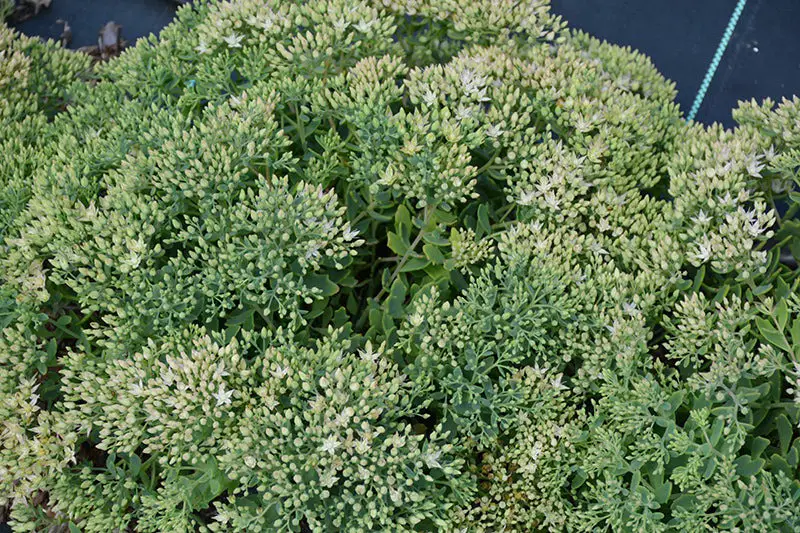
Sedum ‘Thundercloud’ is a striking variety known for its broad, powdery blue-gray foliage and airy, cloud-like flower heads. The foliage forms a dense mound, giving the plant a solid presence in borders and rock gardens even before it blooms.
In late summer to early fall, it produces soft pink flowers that contrast gently with the cool-toned leaves. The blooms attract butterflies and bees while providing a long-lasting show that holds ornamental value even as they dry.
This variety performs best in full sun and well-drained soil. Hardy in USDA zones 3–9, ‘Thundercloud’ is drought-tolerant and low-maintenance, making it ideal for xeriscaping or mass planting where minimal upkeep is desired.
Sedum ‘Lidakense’
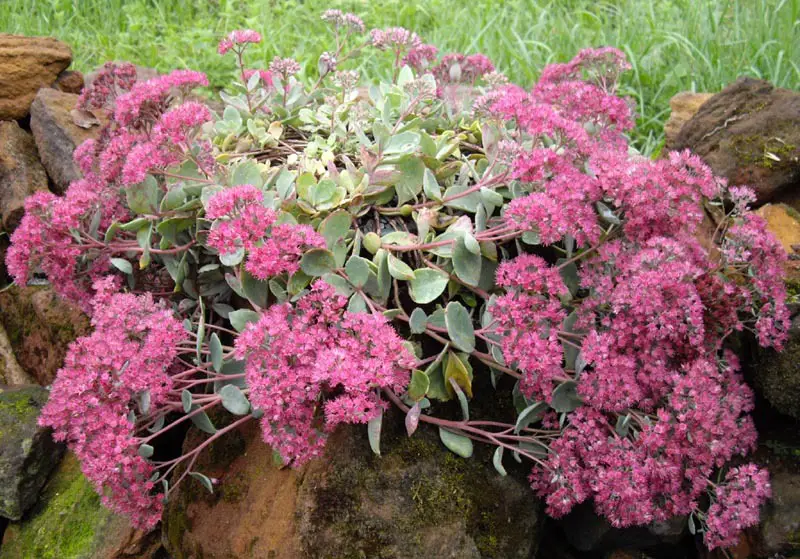
Sedum ‘Lidakense’ is a low-growing, mat-forming succulent with rounded, bluish-gray leaves that often develop rosy or purple tones in cool weather. Its compact size and coloring make it a favorite for edging, containers, or crevices in rock gardens.
During late summer, it produces rosy-pink flowers in small clusters above the foliage, drawing in pollinators. The plant spreads gently without becoming invasive and provides year-round interest thanks to its colorful leaves.
‘Lidakense’ thrives in full sun and well-drained soil. Hardy in USDA zones 6–9, it requires little care beyond occasional pruning and prefers to stay dry between waterings, especially in cooler seasons.
Sedum ‘Touchdown Teak’
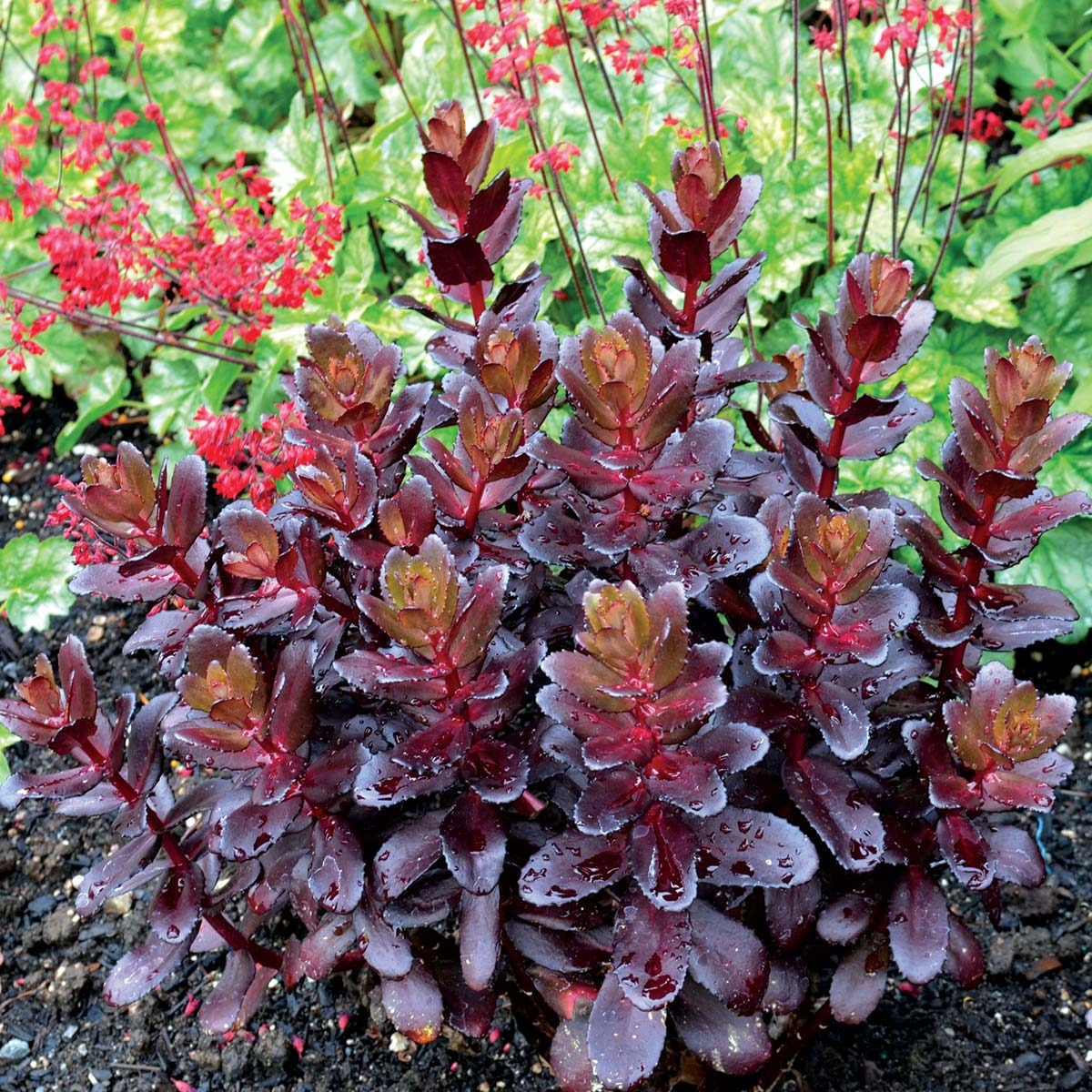
Sedum ‘Touchdown Teak’ is a dramatic, upright sedum cultivar with rich, dark burgundy to almost chocolate-colored foliage that keeps its color through the growing season. It adds strong contrast and modern flair to perennial beds or mixed containers.
In late summer, large clusters of soft pink flowers emerge, sitting above the foliage like delicate cushions. These blooms offer a strong visual contrast and attract bees and butterflies to the garden.
Best grown in full sun and well-drained soil, ‘Touchdown Teak’ is hardy in USDA zones 4–9. It is drought-resistant and maintains its compact shape without flopping, making it a practical and ornamental choice for structure and seasonal color.
Sedum ‘Firecracker’
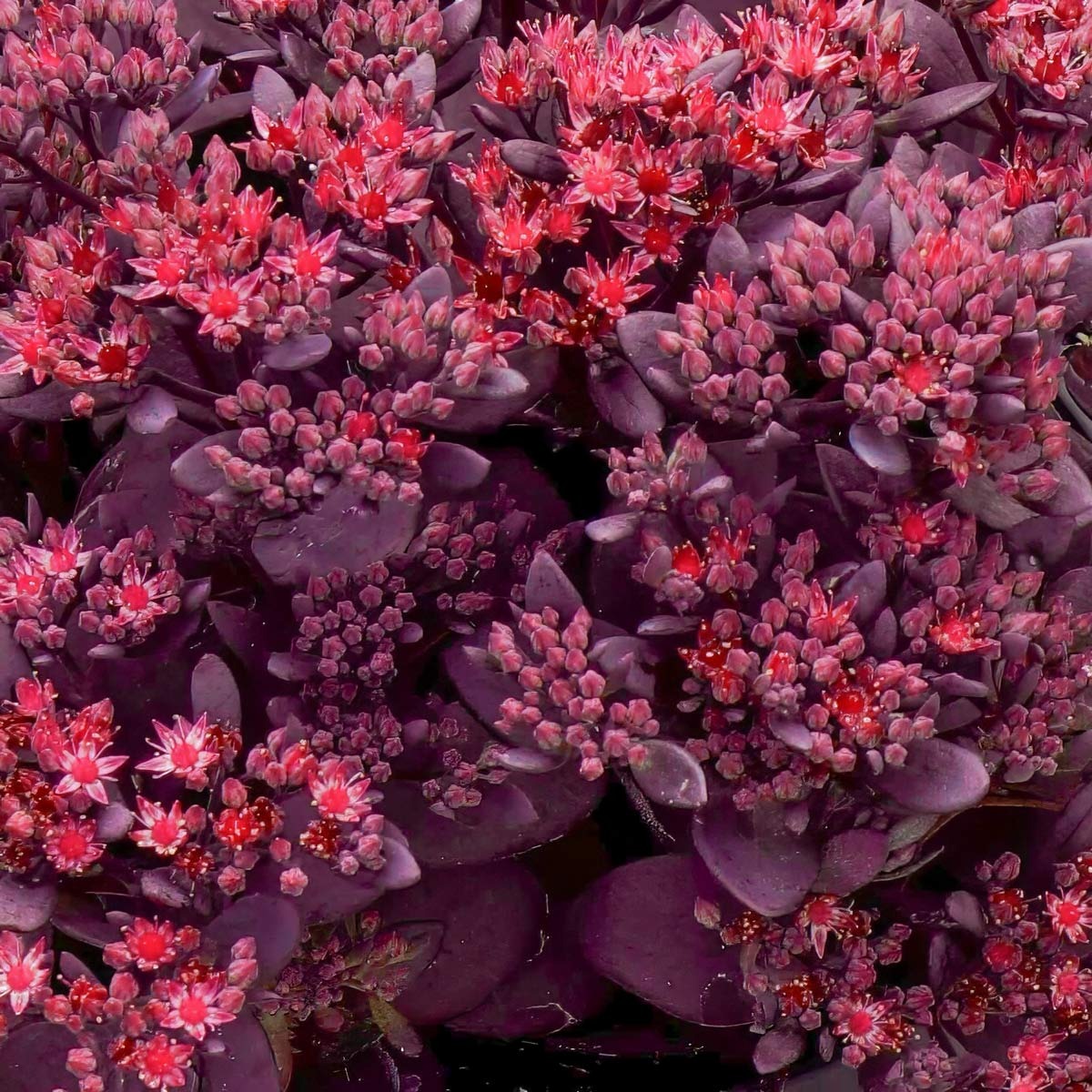
Sedum ‘Firecracker’ is a low-growing cultivar prized for its vibrant burgundy-red foliage that holds color from spring through fall. It forms dense mats, making it a colorful and effective ground cover for sunny spaces.
Bright pink star-shaped flowers bloom in midsummer, creating a striking contrast with the red leaves. The blooms attract pollinators and provide a bright pop of color that enhances rock gardens, slopes, or containers.
This sedum thrives in full sun and sandy or gritty soil. Hardy in USDA zones 4–9, it is exceptionally drought-tolerant and requires minimal maintenance, needing only occasional trimming to maintain its compact, spreading habit.
Sedum ‘Postman’s Pride’
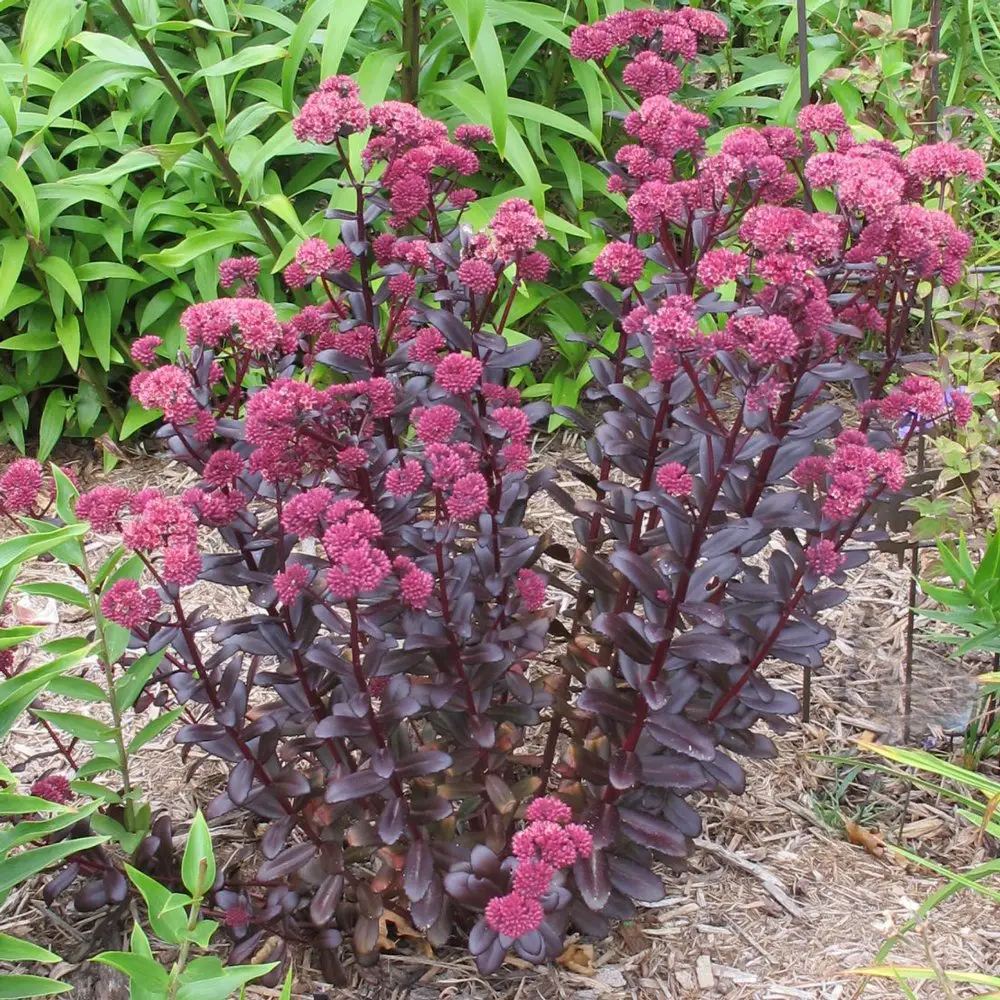
Sedum ‘Postman’s Pride’ is a robust, upright variety known for its deep purple-black foliage that retains its rich color throughout the growing season. Its strong vertical growth makes it ideal for adding depth and contrast to garden beds.
Tight clusters of pinkish-lavender flowers appear in late summer, forming a vivid canopy above the dark leaves. The flower heads are long-lasting and attractive to bees and butterflies, enhancing both color and life in the landscape.
This sedum prefers full sun and well-drained soil. Hardy in USDA zones 3–9, it tolerates drought and poor soil, making it an excellent low-maintenance plant for borders, backdrops, or mass plantings.
Sedum ‘Mr. Goodbud’
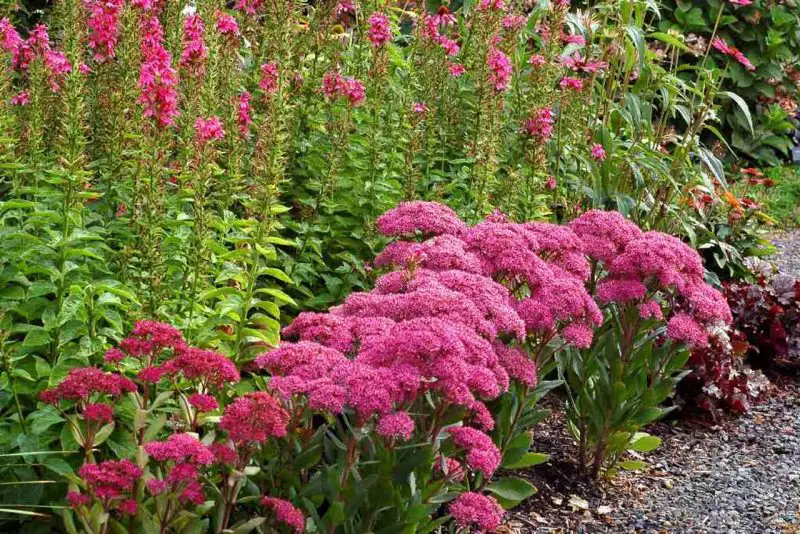
Sedum ‘Mr. Goodbud’ is a standout cultivar featuring fleshy, blue-green leaves and sturdy purple stems. It grows upright and full, forming a compact mound that supports large, domed clusters of vibrant mauve-pink flowers.
The flowers bloom from late summer into fall and are known for their intensity and longevity. They contrast beautifully with the cooler-toned foliage and attract plenty of butterflies and pollinators to the garden.
‘Mr. Goodbud’ thrives in full sun and well-drained soil. Hardy in USDA zones 3–9, it is ideal for perennial borders and requires little maintenance beyond spring cleanup and occasional division to maintain vigor.
Sedum ‘Autumn Charm’
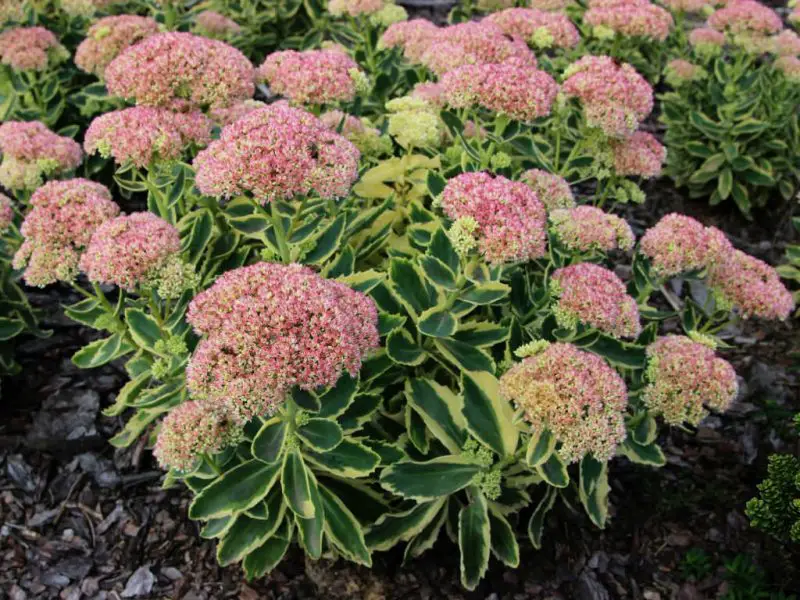
Sedum ‘Autumn Charm’ is a variegated sport of the popular ‘Autumn Joy’, distinguished by its green leaves edged in creamy white. This upright variety brings multi-season interest to the garden, with bold foliage that brightens mixed beds or borders.
In late summer, it produces clusters of rosy-pink flowers that gradually deepen to copper as they mature. These blooms sit atop sturdy stems and draw pollinators while maintaining visual appeal well into fall and early winter.
This variety grows best in full sun and well-drained soil. Hardy in USDA zones 3–9, ‘Autumn Charm’ is drought-tolerant, deer-resistant, and low-maintenance, making it a great choice for gardeners seeking reliable color and structure.
Sedum ‘Neon’
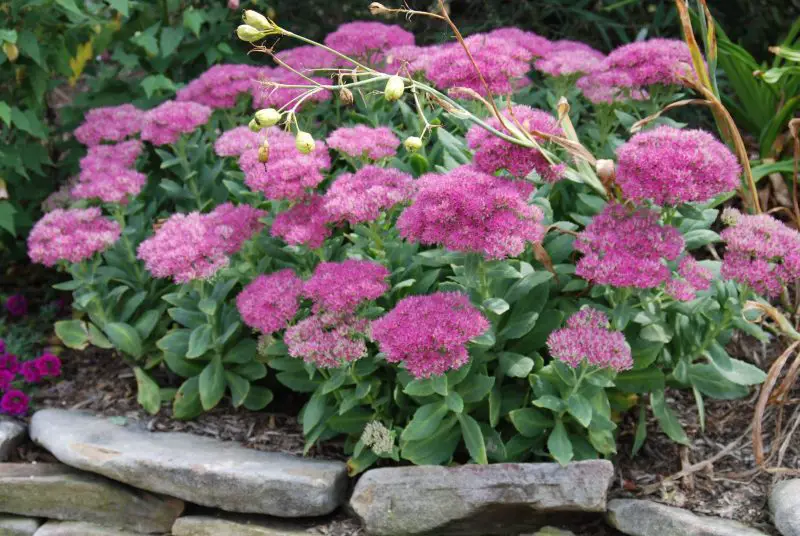
Sedum ‘Neon’ is an eye-catching cultivar with electric pink flower heads and bright green foliage. It shares the upright growth habit of ‘Autumn Joy’ but offers a much more vibrant floral display that stands out in any sunny garden bed.
Blooming from late summer into fall, the flowers appear in dense, rounded clusters and are especially attractive to bees and butterflies. The contrast between the vivid flowers and lush foliage creates a striking garden focal point.
This sedum is best grown in full sun with well-drained soil. Hardy in USDA zones 3–9, it tolerates drought and poor soil conditions, thriving with minimal care and only occasional division to maintain its vigor.
Sedum ‘SunSparkler® Dazzleberry’
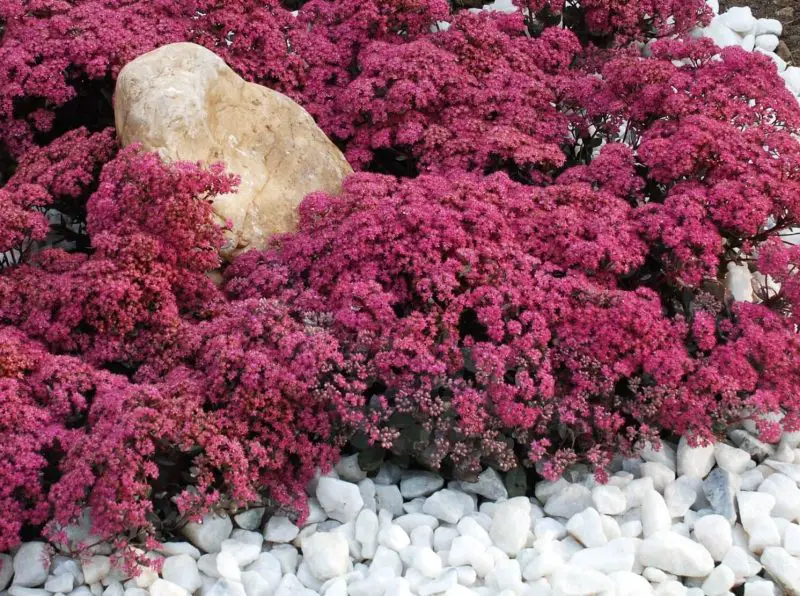
Sedum ‘SunSparkler® Dazzleberry’ is a compact, ground-hugging cultivar with smoky blue-gray foliage and bold raspberry-red flower clusters. Its foliage forms tight mounds that spread nicely in borders or containers.
The vivid flowers bloom in mid to late summer, creating one of the most dramatic color contrasts among sedums. The flower clusters can reach up to 9 inches across and are highly attractive to pollinators.
‘Dazzleberry’ prefers full sun and well-drained soil. Hardy in USDA zones 4–9, it’s drought-resistant, easy to care for, and excellent for mass plantings, rock gardens, or adding bold color to small spaces.
Sedum ‘SunSparkler® Lime Zinger’

Sedum ‘SunSparkler® Lime Zinger’ features lime-green foliage with bright cherry-red edges, offering stunning visual contrast throughout the growing season. Its tidy, mat-forming habit makes it ideal as a colorful ground cover.
In late summer, it produces clusters of vibrant pink flowers that sit above the foliage, creating a beautiful carpet of color that lasts into fall. The foliage retains its variegation and continues to look fresh even in poor soils.
Hardy in USDA zones 4–9, this variety thrives in full sun and well-drained soil. It is both drought-tolerant and easy to grow, needing little more than occasional trimming to stay neat and full.
Sedum ‘SunSparkler® Firecracker’
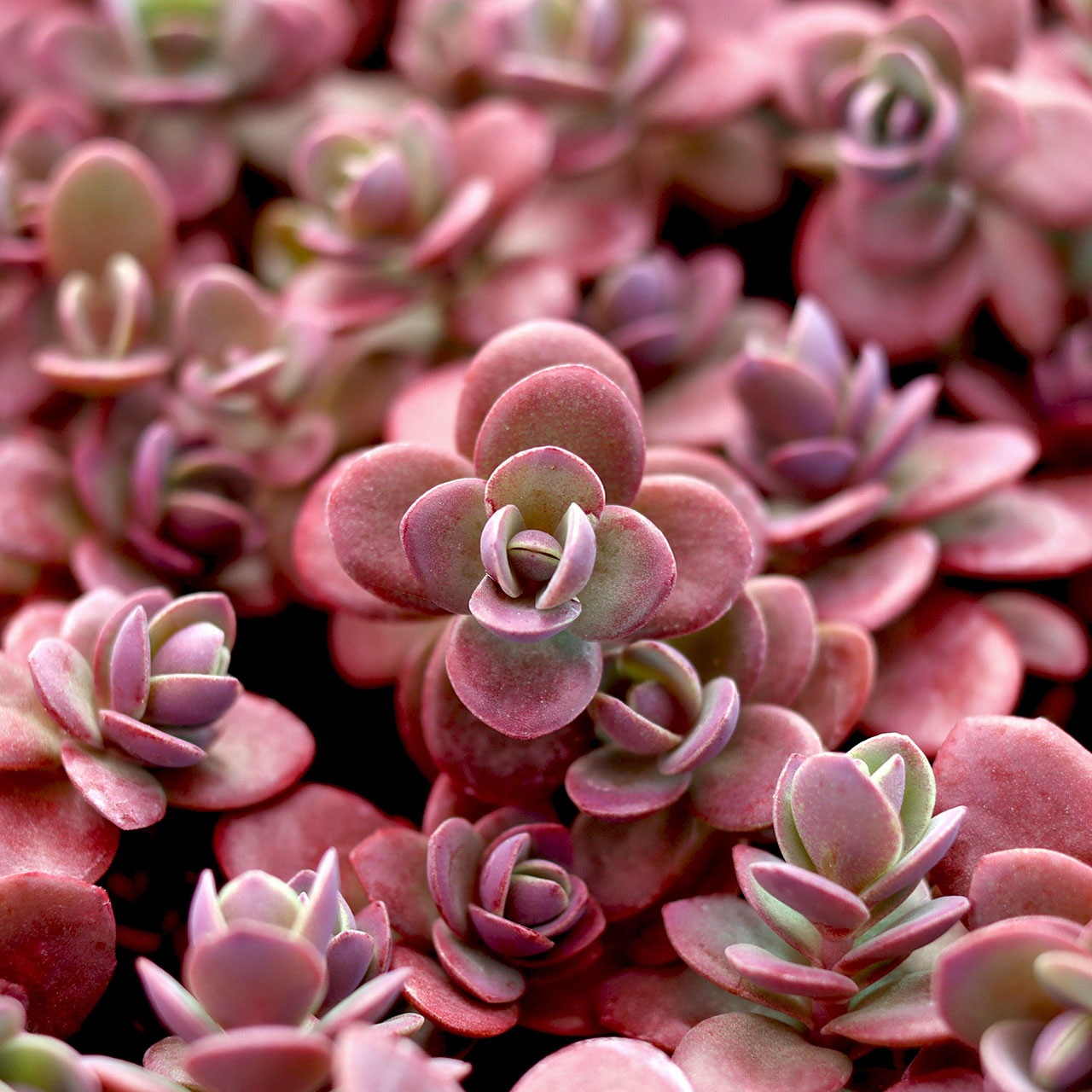
Sedum ‘SunSparkler® Firecracker’ lives up to its name with brilliant burgundy-red foliage and bright pink flowers. Its low-growing, spreading habit forms colorful mats that add vibrancy to rock gardens, containers, and edging.
The flowers bloom in late summer, attracting bees and butterflies while enhancing the bold color palette already present in the foliage. The plant stays neat and compact, making it a favorite for small garden spaces.
This variety thrives in full sun and well-drained soils. Hardy in USDA zones 4–9, ‘Firecracker’ is drought-resistant and heat-tolerant, requiring minimal upkeep to maintain its attractive form and vivid coloring.
Sedum ‘SunSparkler® Blue Pearl’
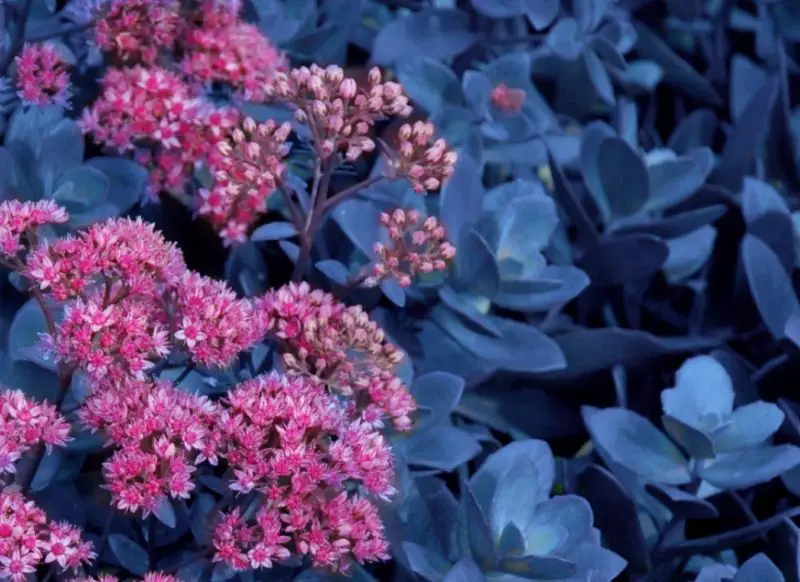
Sedum ‘SunSparkler® Blue Pearl’ stands out with its deep blue-purple foliage and rich magenta flower clusters. Its foliage offers year-round interest, making it one of the most striking color contrasts in the SunSparkler® series.
Flowering in late summer to early fall, the vivid blooms attract pollinators and add even more visual drama. The plant’s low, spreading habit allows it to fill spaces easily and works well in containers, borders, or mass plantings.
This cultivar grows best in full sun and well-drained soil. Hardy in USDA zones 4–9, ‘Blue Pearl’ is highly tolerant of drought and poor soil and thrives with very little maintenance.
Sedum ‘Chocolate Drop’

Sedum ‘Chocolate Drop’ is a unique upright variety known for its dark chocolate-brown foliage that contrasts beautifully with its clusters of bright pink flowers. The plant maintains a compact and tidy habit, making it excellent for garden borders or containers.
From mid to late summer, it produces clusters of star-shaped blooms that attract bees and butterflies. The rich leaf color remains attractive through the growing season, adding depth and contrast to mixed plantings.
It thrives in full sun and well-drained soil, and is hardy in USDA zones 3–9. Like most sedums, it is drought-tolerant, low-maintenance, and resistant to deer and pests, making it easy to care for in a variety of landscapes.
Sedum ‘Hab Grey’
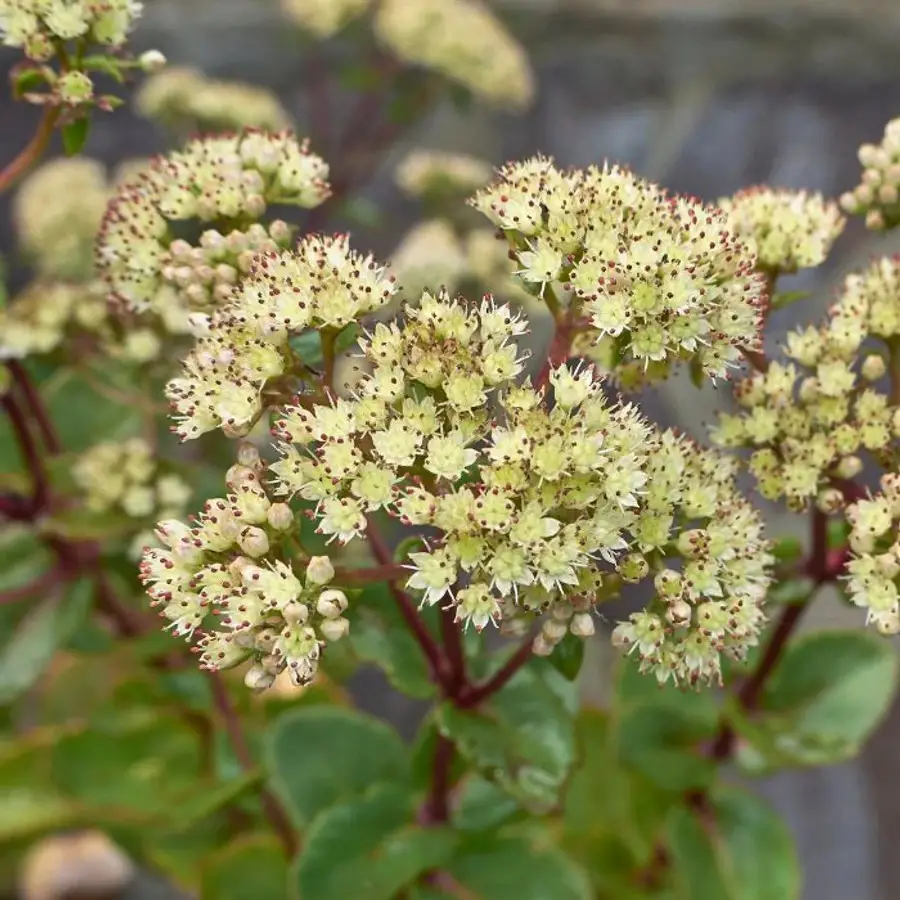
Sedum ‘Hab Grey’ is a low-growing, mat-forming sedum with silvery gray foliage that forms dense ground cover. The leaves have a blue-gray tint that provides a cool, calming tone in the garden and pairs well with bolder perennials.
Small yellow flowers bloom in summer, offering a subtle accent that enhances the foliage’s beauty without overpowering it. Its soft color and tight growth habit make it ideal for rock gardens, green roofs, or edging paths.
This variety prefers full sun and well-draining soil. Hardy in USDA zones 4–9, it tolerates drought, poor soils, and heat, requiring minimal watering and care once established.
Sedum ‘Bertram Anderson’
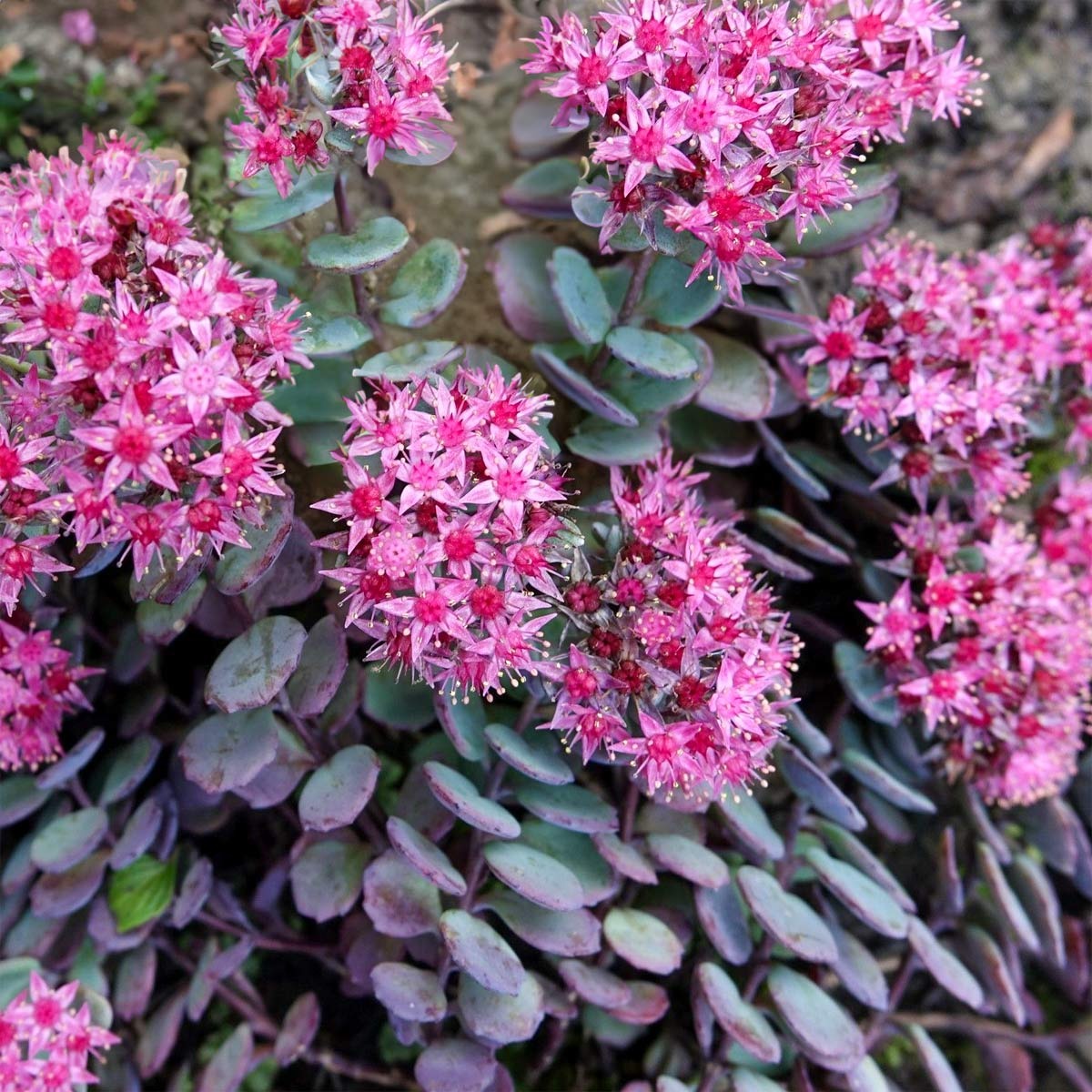
Sedum ‘Bertram Anderson’ is a trailing variety with deep purple-gray foliage and a slightly sprawling habit, making it perfect for ground cover, walls, or container spills. Its unusual coloring offers great contrast in sunny gardens.
In summer, it produces small pink flowers that complement the dark foliage. While the blooms are modest, the plant’s foliage is its main attraction, remaining rich and vibrant throughout the growing season.
This sedum does well in full sun and well-drained soil and is hardy in USDA zones 3–9. It is drought-tolerant, thrives in poor soils, and needs very little maintenance, making it a reliable and decorative choice for low-water gardens.
Sedum ‘Golden Carpet’
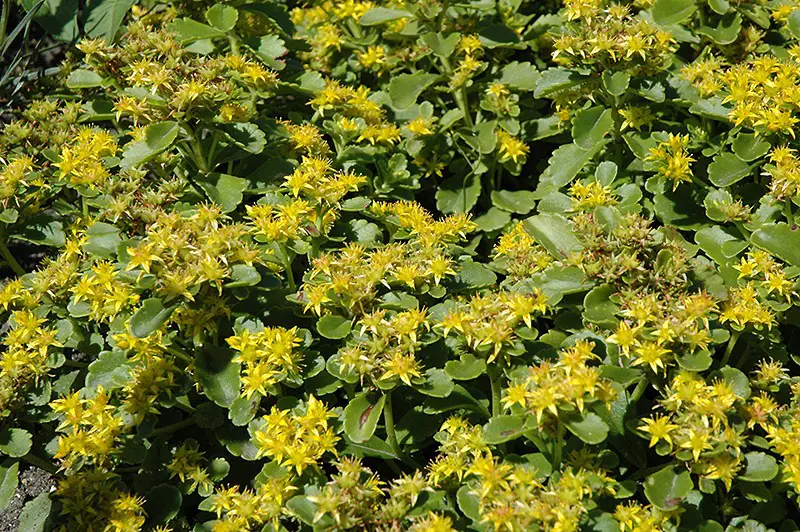
Sedum ‘Golden Carpet’ is a vibrant ground cover sedum with bright yellow-green leaves that form dense, spreading mats. Its low-growing nature and lively color make it a standout in borders, containers, or between stepping stones.
Tiny yellow star-like flowers bloom in late spring to early summer, adding seasonal interest and attracting pollinators. The foliage maintains its golden hue throughout the growing season, even under harsh sunlight.
Best grown in full sun and well-drained soil, it is hardy in USDA zones 3–9. ‘Golden Carpet’ is heat- and drought-tolerant, requires very little water, and spreads readily, making it ideal for erosion control and low-maintenance landscapes.
Sedum ‘Coral Carpet’
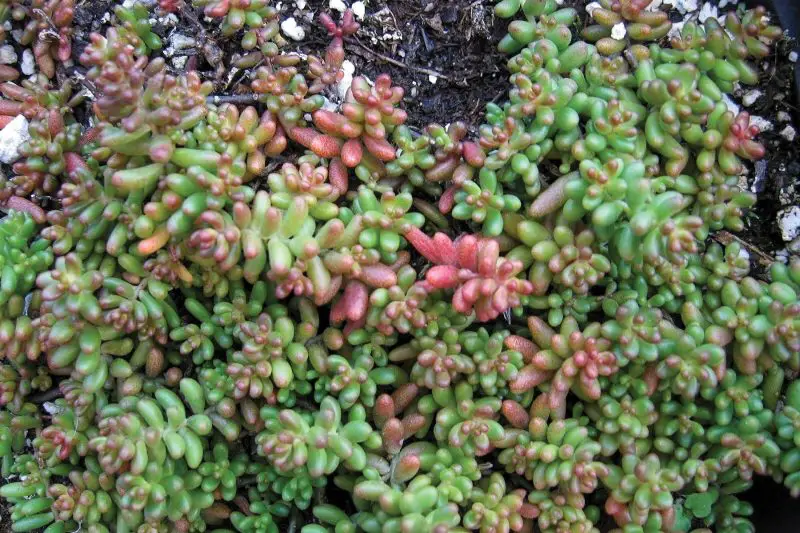
Sedum ‘Coral Carpet’ is a compact, mat-forming variety with soft green to coral-pink leaves that change color with temperature and sunlight. This variety creates a lush carpet of succulent foliage that intensifies in color during cooler months.
In early summer, it produces small pinkish-white flowers that sit delicately above the foliage. Its changing leaf colors and tidy form make it a favorite for rock gardens, container gardens, and alpine troughs.
This sedum prefers full sun and well-drained soil and is hardy in USDA zones 3–9. It requires little maintenance, is drought-tolerant, and spreads moderately, making it a reliable option for color and texture in sunny areas.
Sedum ‘Cape Blanco’
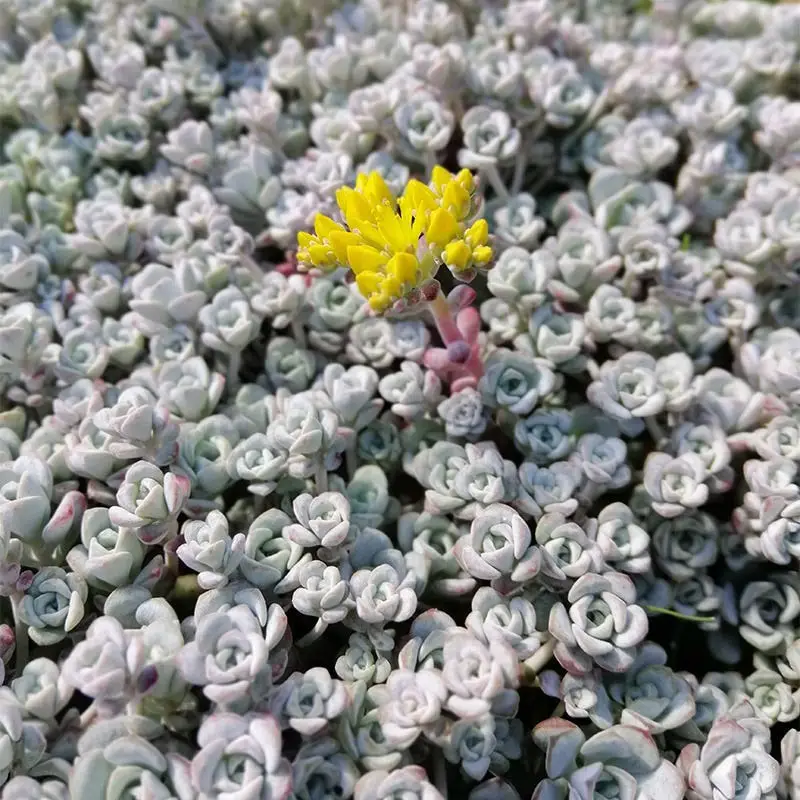
Sedum ‘Cape Blanco’ is a compact, trailing sedum known for its silvery, almost white foliage that gives it a striking appearance in sunny spots. The thick, powdery leaves reflect sunlight and stand out in mixed plantings or rock gardens.
In early summer, it produces small yellow star-shaped flowers that contrast nicely with the frosty leaves. Its trailing habit allows it to cascade gracefully over the edges of containers or walls.
This variety thrives in full sun and well-drained soil. Hardy in USDA zones 5–9, ‘Cape Blanco’ is drought-resistant, needs minimal care, and is excellent for hot, dry conditions where other plants may struggle.
Sedum ‘Sea Star’
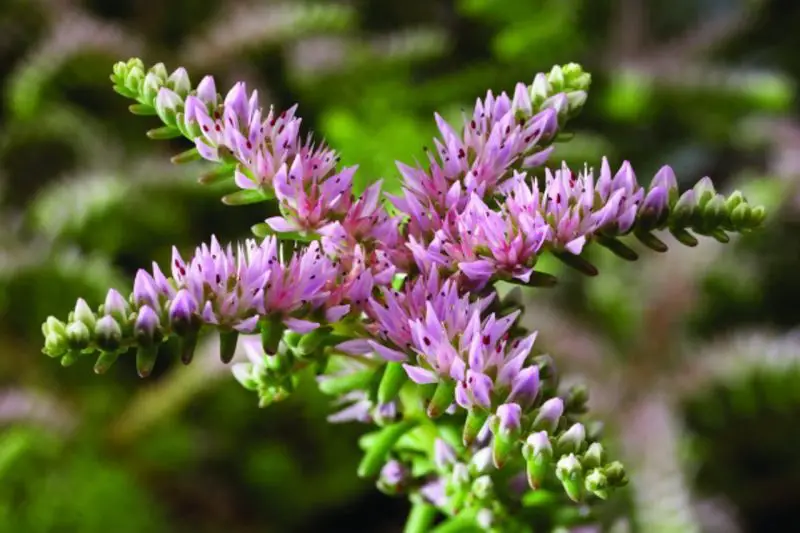
Sedum ‘Sea Star’ is a compact and mounding succulent known for its star-shaped clusters of bright pink flowers that bloom in late summer. The green, fleshy foliage forms neat rosettes, creating a dense and appealing texture in garden beds or containers.
This variety’s symmetrical growth habit and vibrant blooms attract butterflies and pollinators, making it a lively addition to pollinator gardens. The plant remains tidy and ornamental even when not in bloom, with its foliage providing year-round interest.
Best grown in full sun and well-drained soil, ‘Sea Star’ is hardy in USDA zones 3–9. It thrives in drought conditions and needs very little maintenance, making it ideal for rock gardens, border edges, and sunny patio pots.
Sedum ‘Sieboldii Mediovariegatum’
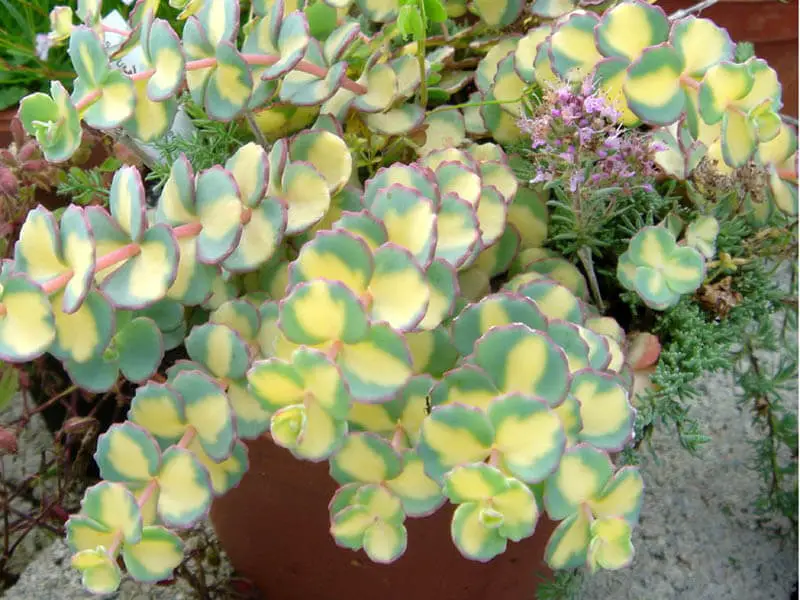
Sedum ‘Sieboldii Mediovariegatum’ is a variegated version of the classic October Daphne, with round blue-green leaves featuring creamy-white centers and pink edges. The foliage grows in graceful, arching stems that create a cascading effect.
In autumn, the plant produces pink flowers that rise above the foliage and bloom just as many other plants begin to fade. The contrast between the variegated leaves and late-season blooms provides exceptional seasonal interest.
This sedum prefers full sun to partial shade and grows best in well-drained soil. Hardy in USDA zones 5–9, it’s drought-tolerant, well-suited for containers and hanging baskets, and adds elegance to rock gardens or sunny borders.
Sedum ‘Tricolor’ (Variegated Caucasian Stonecrop)
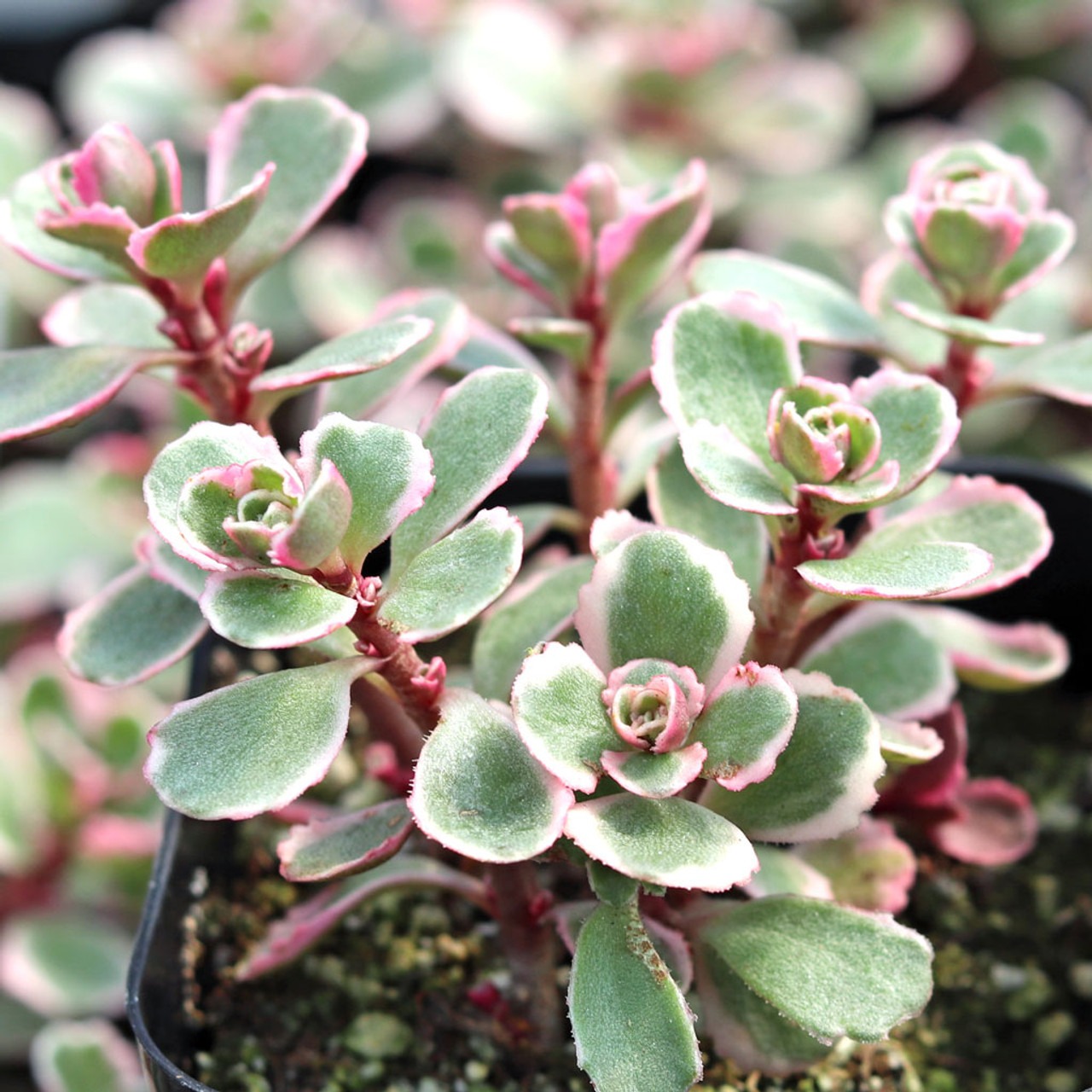
Sedum ‘Tricolor’ is a stunning ground cover with variegated foliage—green centers edged in white and flushed with pink—forming a dense, colorful mat. The plant’s appearance changes with the seasons, becoming more vibrant in cooler weather.
It produces tiny, pinkish-red flowers in summer that complement the colorful foliage. While the blooms are subtle, the true appeal lies in the ornamental leaves, which remain attractive throughout the growing season.
This variety grows well in full sun and well-drained soil, thriving in USDA zones 3–9. ‘Tricolor’ is drought-tolerant, low-growing, and great for borders, rock gardens, or as a colorful filler in containers.
Sedum ‘Elsie’s Gold’
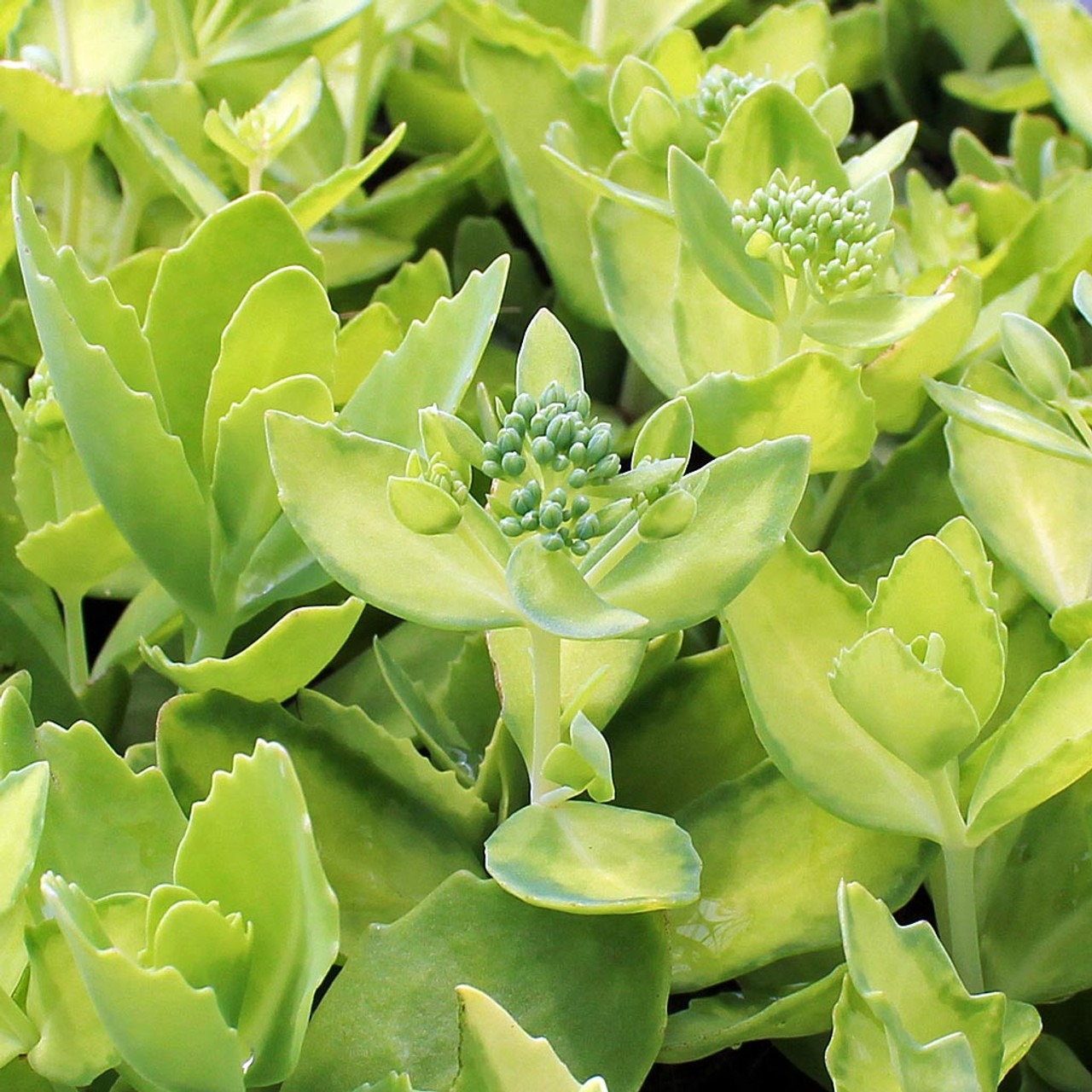
Sedum ‘Elsie’s Gold’ is a compact, clump-forming variety with large green leaves edged in golden yellow. In late summer to early fall, it blooms with large, flat-topped clusters of soft pink flowers that attract bees and butterflies.
The foliage maintains its variegation throughout the season, and its neat, upright habit makes it a favorite for formal beds and container displays. It pairs well with ornamental grasses and other sun-loving perennials.
Grow ‘Elsie’s Gold’ in full sun and well-drained soil. It is hardy in USDA zones 3–9, tolerant of drought, and requires minimal care. Prune back in early spring to encourage full growth and maintain its compact shape.
Sedum ‘Jose Aubergine’
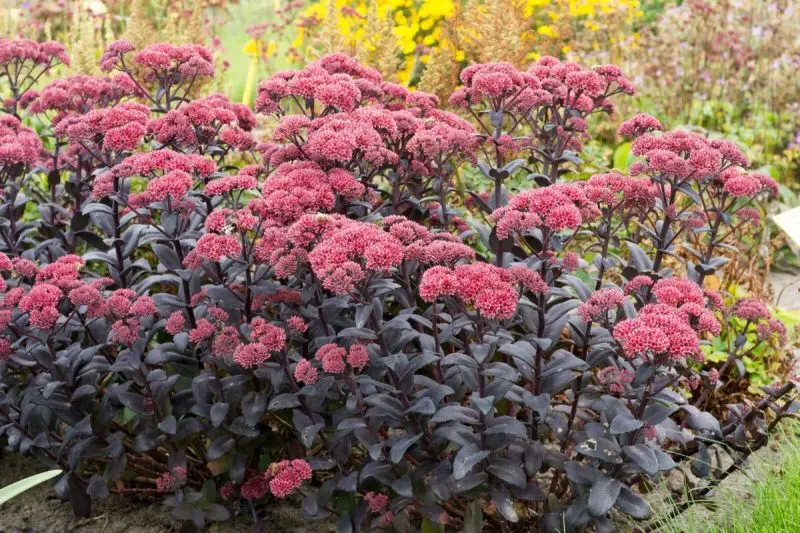
Sedum ‘Jose Aubergine’ is an eye-catching upright variety with deep burgundy foliage that darkens as the season progresses. Its dramatic coloring makes it a standout in mixed borders or modern garden designs.
From late summer to fall, it produces clusters of bright pink flowers that contrast beautifully against the dark leaves. The blooms attract bees and other pollinators while the foliage provides structure and color throughout the growing season.
This sedum thrives in full sun and well-drained soil and is hardy in USDA zones 4–9. It tolerates drought well, is low maintenance, and can be divided every few years to rejuvenate growth and maintain vigor.
Sedum ‘Munstead Dark Red’
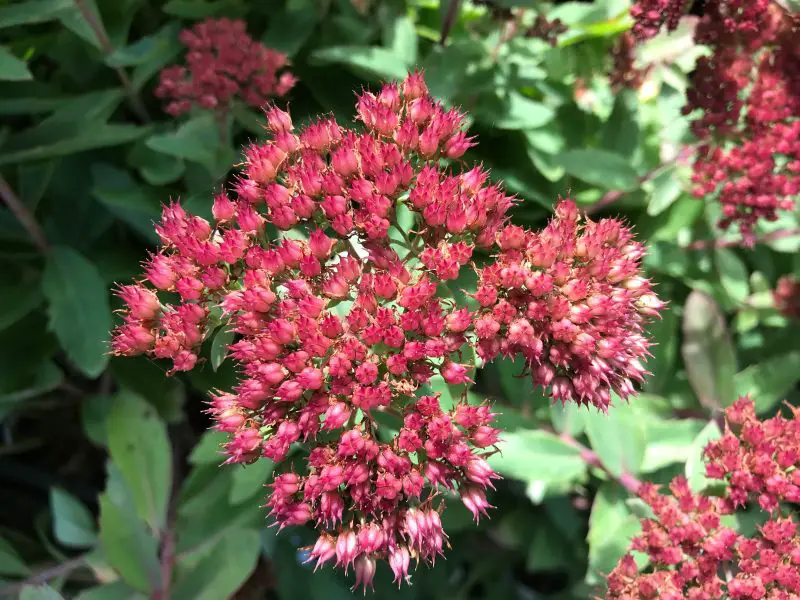
Sedum ‘Munstead Dark Red’ features compact, upright growth with fleshy green leaves and clusters of deep red flowers that appear in late summer and early fall. The blooms become richer as they age, creating long-lasting garden color.
The contrast between the green foliage and dark red blooms adds depth to perennial borders and pollinator gardens. It remains visually interesting even after flowering as the seed heads dry and persist into winter.
Hardy in USDA zones 3–9, this sedum prefers full sun and well-drained soil. It is drought-tolerant, deer-resistant, and ideal for sunny spots in cottage gardens, mixed beds, or containers.
Sedum ‘Weihenstephaner Gold’
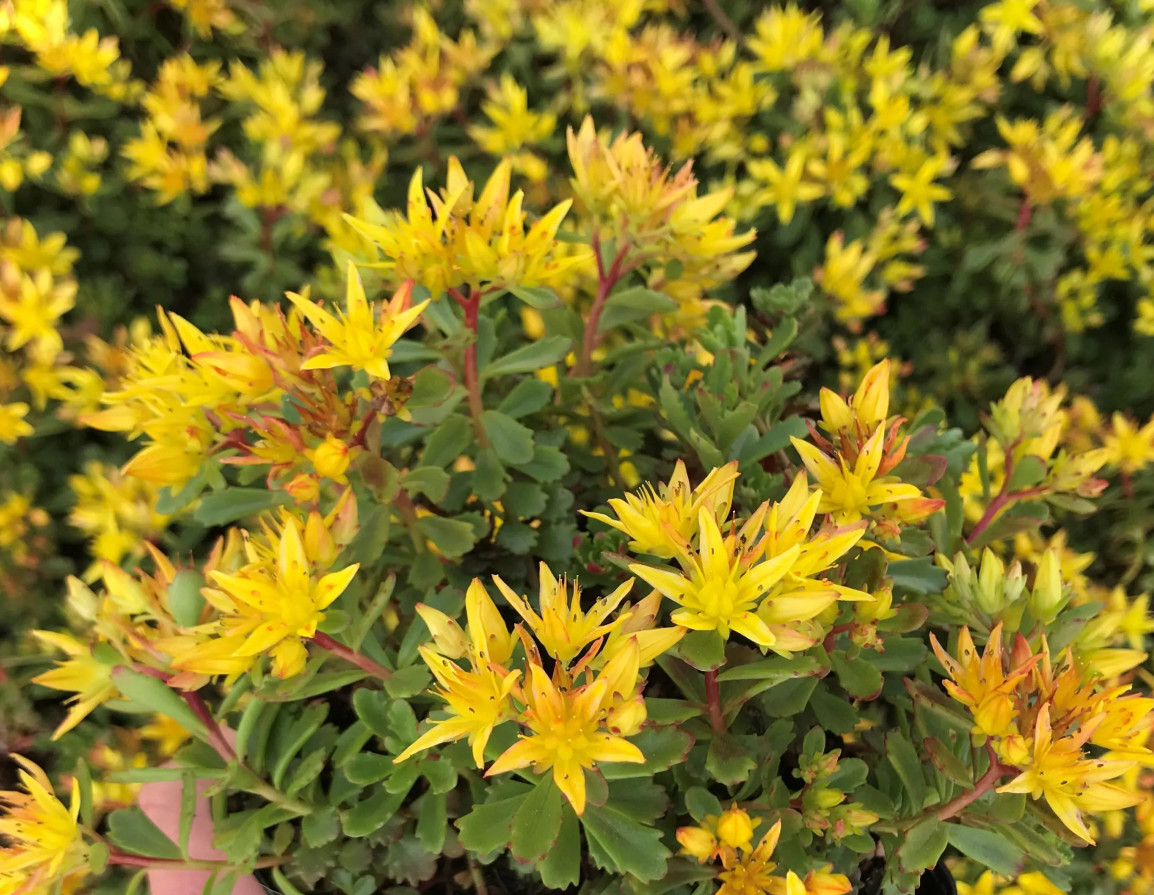
Sedum ‘Weihenstephaner Gold’ is a spreading ground cover with small, scalloped leaves that change from green to reddish-bronze in cool weather. It forms a dense mat that is ideal for rock gardens, slopes, and edging paths.
Bright yellow star-shaped flowers bloom in late spring to early summer, creating a cheerful display that draws in pollinators. The foliage color shift adds seasonal interest beyond the flowering period.
Grow this variety in full sun and well-drained soil. It is hardy in USDA zones 3–9, highly drought-tolerant, and performs well in poor or sandy soils. Little maintenance is needed aside from occasional trimming.
Sedum ‘Green Ball’
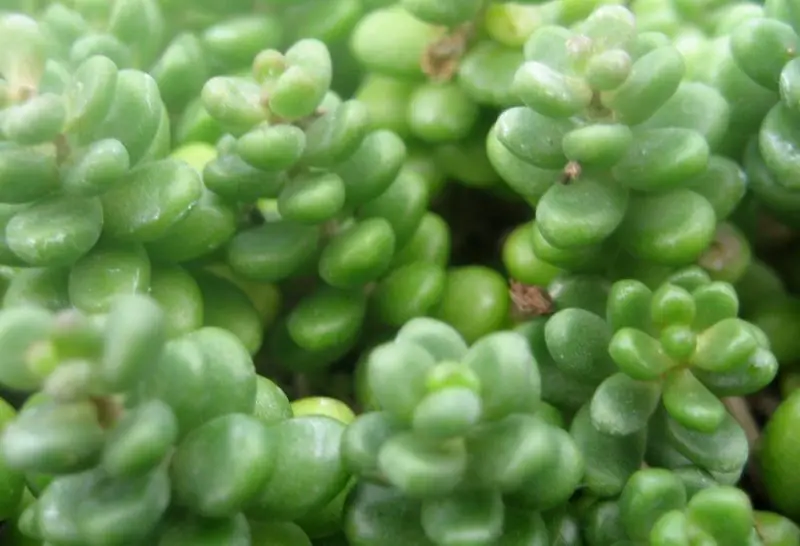
Sedum ‘Green Ball’ is a compact, mound-forming sedum with densely packed, needle-like green foliage that resembles a cushion or mossy ball. Its tidy, spherical form adds unique texture and shape to sunny landscapes.
It produces small yellow blooms in summer, but its standout feature is the foliage, which remains vibrant and full through most of the year. The plant’s tidy shape makes it great for edging or mass planting.
This sedum is best suited for full sun and well-drained soil and is hardy in USDA zones 3–9. Like other sedums, it is low-maintenance, drought-tolerant, and performs well in xeriscapes or dry, sunny rockeries.


